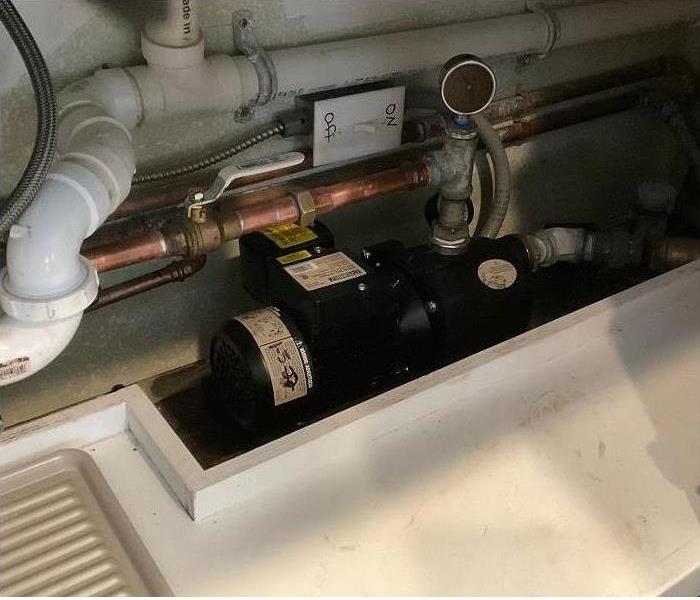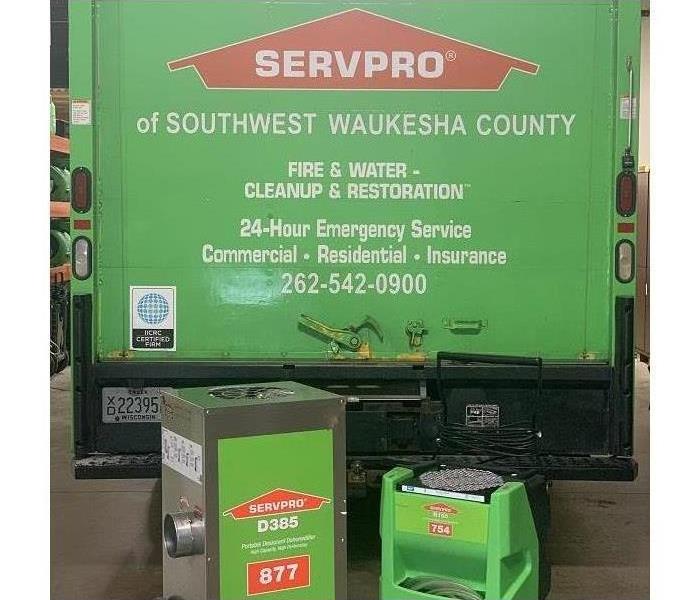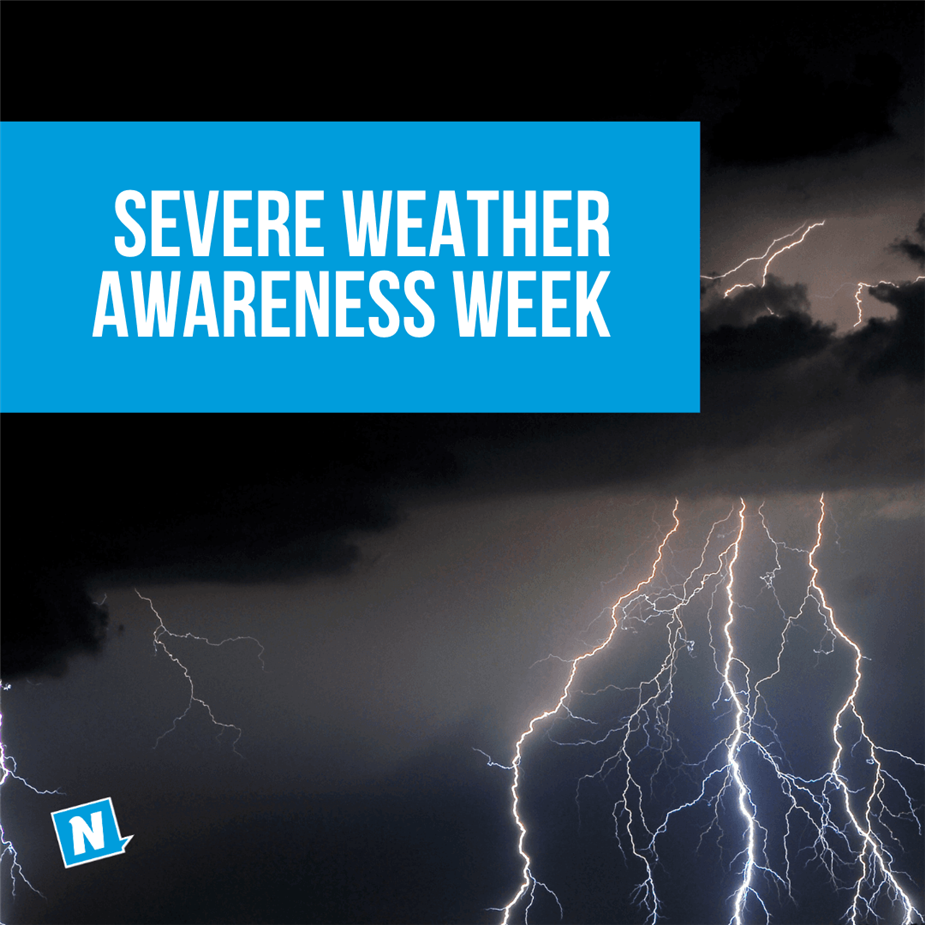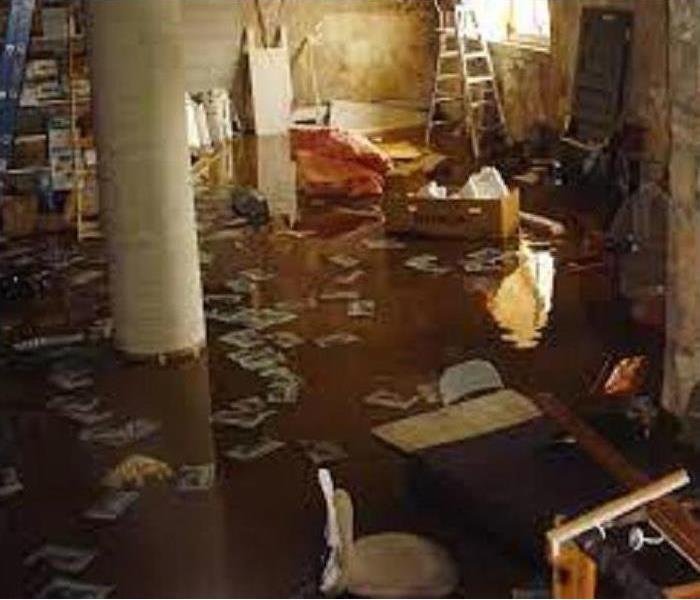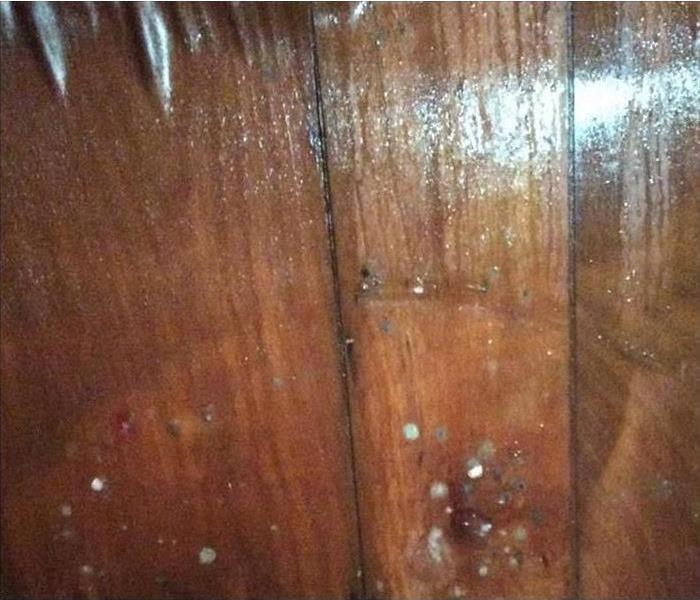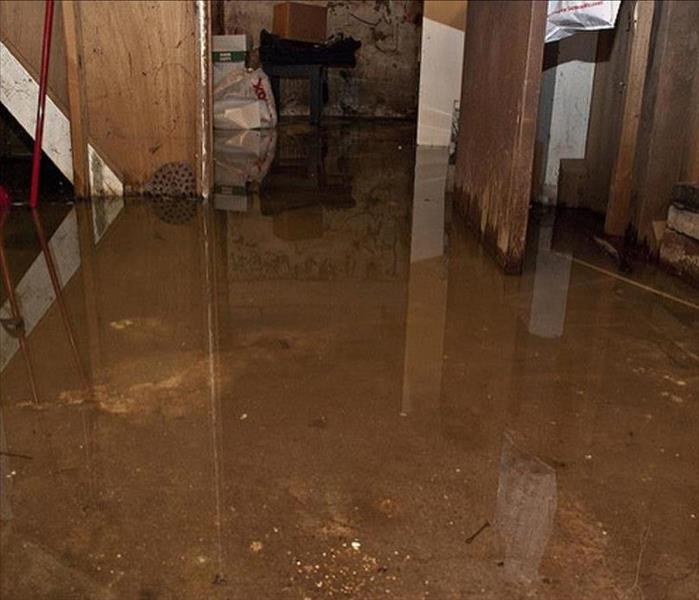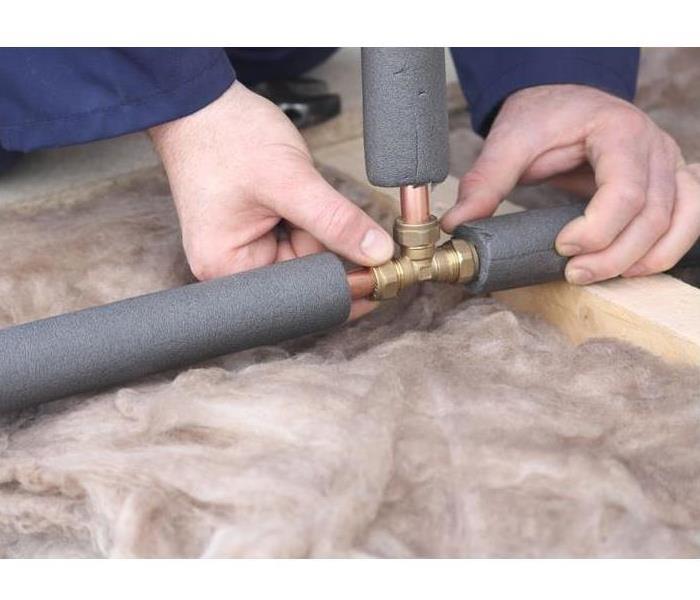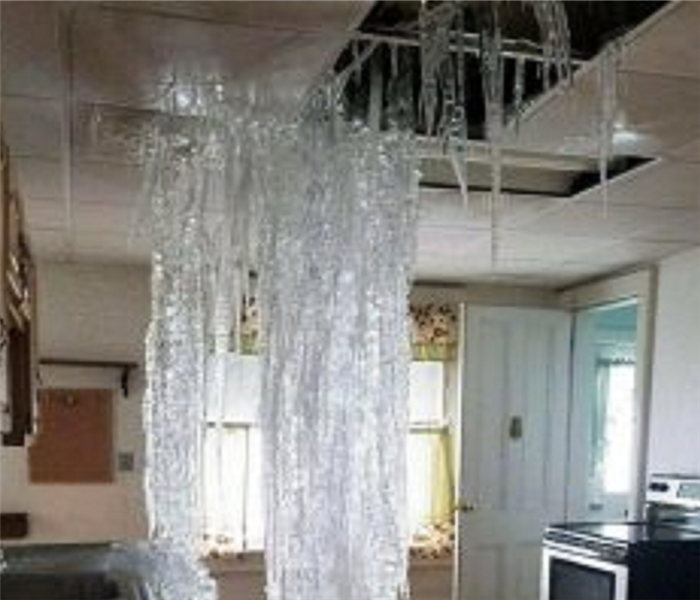Recent Water Damage Posts
Failed well pump causes water damage
9/1/2023 (Permalink)
A well pump that failed led to significant water damage at this property on Okauchee Lake. This picture shows the new well pump that was installed by a licensed plumber because the former one developed a crack and slowly leaked water into the kitchen. This kitchen was recently remodeled and the cabinets were installed on top the new vinyl tile. Because the water migrated under the vinyl tile and there was no way to dry the floor through the vinyl, the sink had to be removed, granite countertops removed, cabinets detached and flooring removed so that the subfloor could be dried.
SERVPRO of Jefferson County/Oconomowoc was called in to clean the disaster and coordinate the demo and dry out the structure. The property owner was happy with SERVPRO because we were able to begin the same day and his tenant would be inconvenienced for as short a time as possible.
Please call SERVPRO of Jefferson County/Oconomowoc or SERVPRO of SW Waukesha Count for all your water damage needs, both commercial and residential. 920-674-3002 or 262-542-0900.
Desiccant vs. Dehumidifier
8/1/2023 (Permalink)
Desiccant dehu vs Compressor dehu
SERVPRO of SW Waukesha County and SERVPRO Jefferson County/Oconomowoc use both types of dehumidifiers on our jobs. The commercial grade Phoenix D385 dehumidifier units are used for large jobs or cold temperature situations.
A desiccant dehumidifier functions by drawing air through an intake duct, where it is then passed through a large rotating wheel composed of a water-absorbing material (desiccant). This is a material that absorbs the humidity from the air. The air is then pushed by a fan operated by an electric motor and the air is blown back out into the room. The air duct is often kept hot by an electric heating element, which also heats the airspace within the rotating wheel to dry it out. Excess moisture is ran through a drain line or directly outside through lay flat ducting creating a negative air process if viable. In some cases, a desiccant is ducted directly into a standard compressor dehumidifier. This is a viable option for above average moisture levels accompanied by a secondary heat source to get rapid drying done in large spaces.
When it comes to using a standard low-grade refrigerant dehumidifier in an area such as a basement, garage, or space below 60 degrees, it is important to know that these dehumidifiers will often have trouble working to their full potential. This is due to the fact that the inside of a compressor dehumidifier needs to be colder than the ambient air in the space it is occupying in order for it to work efficiently. If the room temperature falls below 50°, it means that the components within a compressor dehumidifier will be close to freezing, which means that ice could form on the cooling coils. Most compressor dehumidifiers will spend the majority of their time defrosting themselves when faced with temperatures below or around 50°.
With this being said it is important to know when it would be better to implement the use of a desiccant dehumidifier vs a standard compressor dehumidifier.
For all your water damage questions or needs, please contact a certified water restoration technician. The SERVPRO of SW Waukesha County location is 262-542-0900 and our SERVPRO of Jefferson County/Oconomowoc location is 920-674-3002
How to prepare for thunderstorms
5/20/2023 (Permalink)
Spring can bring lots of rainy weather and thunderstorms. Here are our top tips on how to prevent water damage and ensure your safety.
To keep your property safe:
- Keep up with your home maintenance- replace missing shingles and loose siding to prevent water from leaking in and damaging your home.
- Check your sump pump- make sure it is in working order to prevent basement flooding.
- Check for loose fence posts- anything that's not secured can be blown into your house by the wind and cause damage.
- Trim your trees- make sure dead branches are removed to prevent them falling on your home or car.
- If bad thunderstorms are in the forecast, have a generator on hand for the event of a possible power outage and prepare and emergency kit with flashlights, batteries and a first aid kit.
To keep you safe:
- Check the forecast- be aware if a bad thunderstorm is predicted for your area.
- When thunder roars, go indoors- try to get out of the storm and find shelter inside in the event of a thunderstorm.
- Stay dry- do not shwer, wash dishes or run water during a thunderstorm and avoid bodies of water.
How to prevent flooding in your home
5/20/2023 (Permalink)
As is the danger in every spring flooding is always a possibility as the snow melts and the spring showers roll around. Flooding is very dangerous for all homeowners if they are not properly equipped to handle the flooding. There are many different ways that you can handle flooding, but it is most important to know how to prevent it, and what actions you can take if you still experience flooding.
Preventative Measures
- Apply coatings and sealants. A form of "dry flood-proofing," coatings and sealants that you apply to your foundation, walls, windows and doorways help prevent flood water from leaking into your house through cracks.
- Raise your electrical outlets and switches. All outlets, switches, sockets and circuit breakers should be at least one foot above flood level to avoid significant electrical damage in the case of a flood.
- Install check valves on your pipes. Make sure that all pipes entering your house have valves to prevent a flooded sewage system from backing up into your home. Gate valves are preferred over flap valves, since they provide a better seal against flood pressure.
- Grade your lawn away from the house. If your lawn tilts toward your house, rainwater will pool around your home. Use a heavy soil that contains clay and sand to regrade your lawn so that surface runoff empties into an appropriate place, such as a street gutter.
- Leave space between mulch and siding. Wet mulch can rot your house's siding, which in turn can lead to leaks. Keep space between your mulch and siding so that the base of your house can completely dry after rainstorms.
- Point your downspouts away from your home. If your gutter runoff is not pointed away from your house in an appropriate direction, it can pool at the corners of your house and may eventually create leaks in your basement.
However these preventive steps are not full proof, and it is important to know how to handle flooding if it does occur.
How to Stop Flooding Once it Starts
- Turn off the water line, if that is the source of the flooding.
- Clear out gutters and drains so that water can flow freely.
- Use sandbags to block any gaps that will lead to flooding.
- Move rugs, furniture, electronics and other valuables to a higher floor of the home, or elevate them.
- Shut off your electricity at the breaker panel, if flood water is close to reaching your electrical system.
- If it's not raining, open windows to allow air flow through your home.
- Turn on your sump pump or use a shop vacuum to remove water as quickly as possible.
These measures will help minimize the damage that the flooding can cause.
For any flooding and water damage Call SERVPRO of Southwest Waukesha County at (262) 542-0900
Water Damage in Waukesha Home
4/11/2023 (Permalink)
Over the weekend our crew at SERVPRO of Southwest Waukesha County went to a job site that had water damage. The homeowner was out of town, but a neighbor was watching the house and discover that a pipe had burst. There was water all on the carpet and pad as well as the furniture in the room was damaged by the water.
Our crew discovered that there was more than water damage at this property; mold had started to grow on the wall and other content in the room
This is a reminder to shut off your water if you will be gone for a long period of time. You never know if a pipe would burst or a toilet would overflow while you are gone.
If you have any questions regarding this tip of the week, please call SERVPRO of Southwest Waukesha County at (262) 542-0900.
What Is That "White Stuff" Growing On My Basement Walls?
10/18/2022 (Permalink)
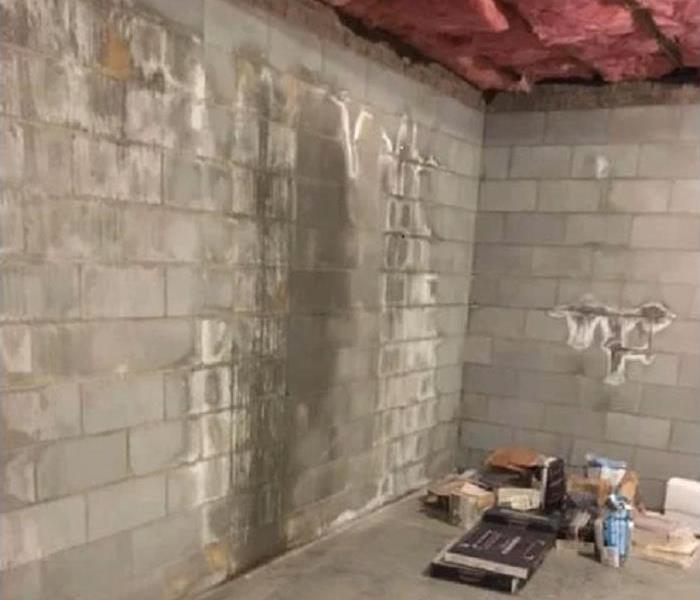 Efflorescence - A Common Problem In Wisconsin Basements
Efflorescence - A Common Problem In Wisconsin Basements
Have you ever seen that white/gray "fuzzy stuff" growing on your basement walls or in someone else's house? Were you worried that it was hazardous? Well, the "fuzzy stuff" is called efflorescense and it is NOT dangerous. It is more annoying and unattractive, but nothing to worry about or nothing that can't be fixed.
If you have a concrete or masonry block foundation, this is a common problem. Efflorescence can be easily removed because it simply is salt. If you observe efflorescence on in your home, this means that you have a water issue that must be taken care of. This moisture problem can cause deterioration if ignored.
The cause of this is water from the outside is penetrating the brick or concrete and comes in contact with minerals. A chemical reaction then takes place and dissolves the minerals. The moisture then migrates to the other side of the block or concrete (the inside of your home) and eventually evaporates. As water evaporates from the surface the mineral deposits are left behind, and these efflorescence crystals can grow.
The concern is that the efflorescence is NOT just on the side of the brick or concrete, but these same crystals can also grow inside the brick or concrete and cause spalling. The definition of spalling the breaking of ore, rock, stone or concrete into smaller pieces or fragments. This spalling can make the surface peel, pop or flake off. The salt pushes from the inside out and can eventually cause crumbling and deterioration.
Hopefully if you remove the efflorescence it does not come back. If it does not return, this probably means that the cause was the initial moisture and salts from when the concrete was placed. However, if the efflorescence does return, this is a clear indication that water is entering the brick or concrete wall and pushing the salts out.
Can I Prevent Efflorescence?
The answer is YES! The best way to prevent the efflorescence is to prevent water from infiltrating the wall. If you see efflorescence crystals it usually means there is a leak somewhere letting outside water in. Once, the source of the water infiltration has been located and stopped then the walls can be cleaned with an efflorescence remover.
While inside systems can divert the water, it may not solve the problem of efflorescence and other moisture-related mineral build-ups. Regardless of what is done on the inside, water is still entering through the wall from the outside.
The salt that ends up as efflorescence crystals on your walls, can come from salt laden soils or the Portland cement in the mortar and grout. The soluble salts could come from the sand or from contaminated water used to make the concrete, grout or mortar.
Another culprit is, of course, the clay brick itself. The natural clays used in the manufacture of brick often contain soluble alkali sulfates. Most modern fired clay brick have balanced chemical additives to immobilize the sulfates and render them insoluble. This prevents the salts from being dissolved into a solution that could migrate through the wall to the surface. Most fired clay brick do not greatly contribute towards the efflorescence problem.
If you have a problem if efflorescence and would like to have it removed, please call the water damage professionals at SERVPRO of SW Waukesha County (262-542-0900) or SERVPRO of Jefferson County/Oconomowoc (920-674-3002).
Desiccant Dehu vs. Low-Grain Refrigerant Dehu
8/31/2022 (Permalink)
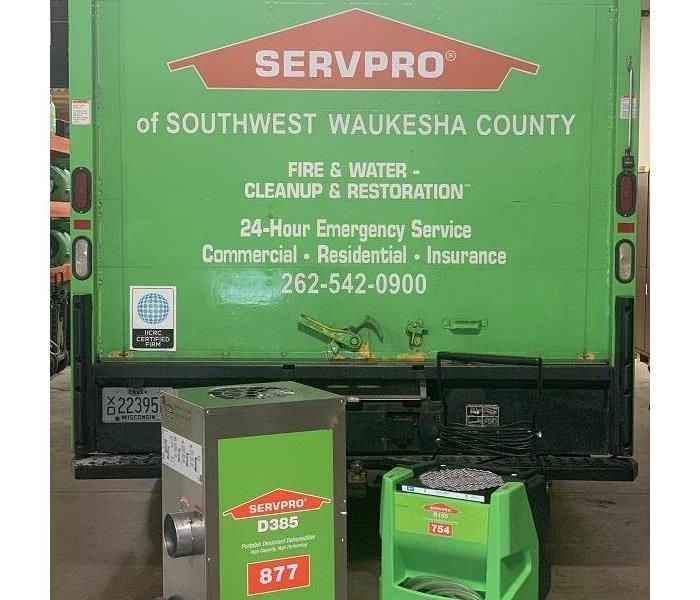 Various Types of Dehumidifiers Used by SERVPRO
Various Types of Dehumidifiers Used by SERVPRO
Desiccant dehu vs Compressor dehu
SERVPRO of SW Waukesha County and SERVPRO Jefferson County/Oconomowoc use both types of dehumidifiers on our jobs. The commercial grade Phoenix D385 dehumidifier units are used for large jobs or cold temperature situations.
A desiccant dehumidifier functions by drawing air through an intake duct, where it is then passed through a large rotating wheel composed of a water-absorbing material (desiccant). This is a material that absorbs the humidity from the air. The air is then pushed by a fan operated by an electric motor and the air is blown back out into the room. The air duct is often kept hot by an electric heating element, which also heats the airspace within the rotating wheel to dry it out. Excess moister is ran through a drain line or directly outside through lay flat ducting creating a negative air process if viable. In some cases, a desiccant is ducted directly into a standard compressor dehumidifier. This is a viable option for above average moister levels accompanied by a secondary heat source to get rapid drying done in large spaces.
When it comes to using a standard low-grain refrigerant dehumidifier in an area such as a basement, garage, or space below 60 degrees, it is important to know that these dehumidifiers will often have trouble working to their full potential. This is due to the fact that the inside of a compressor dehumidifier needs to be colder than the ambient air in the space it is occupying in order for it to work efficiently. If the room temperature falls below 50°, it means that the components within a compressor dehumidifier will be close to freezing, which means that ice could form on the cooling coils. Most compressor dehumidifiers will spend the majority of their time defrosting themselves when faced with temperatures below or around 50°.
With this being said it is important to know when it would be better to implement the use of a desiccant dehumidifier vs a standard compressor dehumidifier.
For all your water damage questions or needs, please contact a certified water restoration technician. The SERVPRO of SW Waukesha County location is 262-542-0900 and our SERVPRO of Jefferson County/Oconomowoc location is 920-674-3002
Spring Thunderstorms and How to Prepare
4/12/2022 (Permalink)
Spring can bring lots of rainy weather and thunderstorms. Here are our top tips on how to prevent water damage and ensure your safety.
To keep your property safe:
- Keep up with your home maintenance- replace missing shingles and loose siding to prevent water from leaking in and damaging your home.
- Check your sump pump- make sure it is in working order to prevent basement flooding.
- Check for loose fence posts- anything that's not secured can be blown into your house by the wind and cause damage.
- Trim your trees- make sure dead branches are removed to prevent them falling on your home or car.
- If bad thunderstorms are in the forecast, have a generator on hand for the event of a possible power outage and prepare and emergency kit with flashlights, batteries and a first aid kit.
To keep you safe:
- Check the forecast- be aware if a bad thunderstorm is predicted for your area.
- When thunder roars, go indoors- try to get out of the storm and find shelter inside in the event of a thunderstorm.
- Stay dry- do not shwer, wash dishes or run water during a thunderstorm and avoid bodies of water.
Watch or Warning - What is the Difference?
1/7/2022 (Permalink)
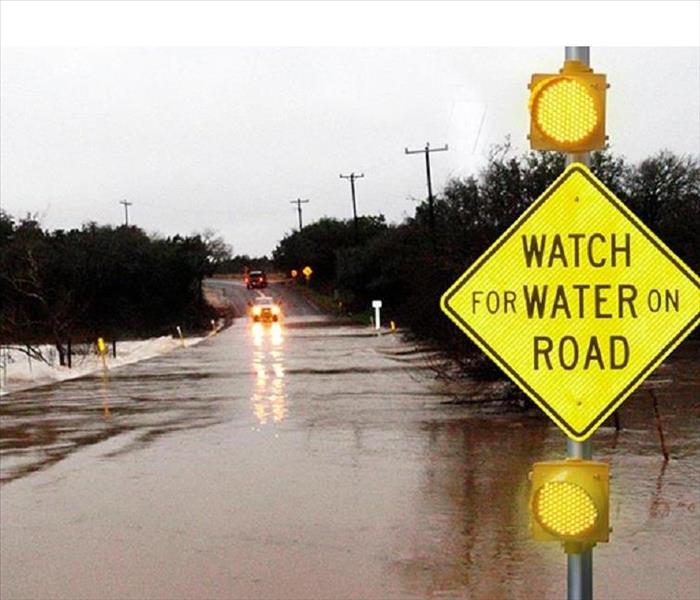 Heavy Rains May Cause Flooding on Roads And In Structures
Heavy Rains May Cause Flooding on Roads And In Structures
Watch or Warning...what is the difference? When storms begin to brew, terminology may begin to sound confusing. Storms can go from light to heavy within the blink of an eye. If the weather becomes dangerous, here are some definitions to help distinguish the severity of them.
Flash Flood Watch: A Flash Flood Watch is issued when conditions are favorable for flash flooding. It does not mean that flash flooding will occur, but it is possible.
Flash Flood Warning: A Flash Flood Warning is issued when flash flooding is imminent or occurring.
Flood Watch: A Flood Watch is issued when conditions are favorable for flooding. It does not mean flooding will occur, but it is possible.
Flood Warning: A Flood Warning is issued when flooding is imminent or occurring.
SERVPRO of SW Waukesha County and SERVPRO of Jefferson County/Oconomowoc is here to help in any case of flooding or water damage that may occur due to a storm. In the event you have a flooding situation in your home, please call us. We are here to help. 262-542-0900 of 920-674-3002
Containment Speeds Up Drying In Water Damaged Areas
1/7/2022 (Permalink)
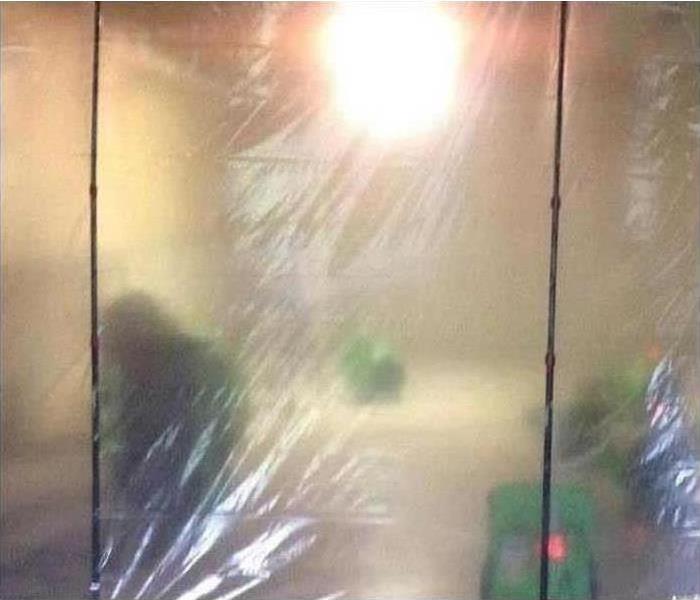 Building Temporary Plastic Walls Helps With Drying
Building Temporary Plastic Walls Helps With Drying
By using a simple containment system, as seen in this commercial property in Oconomowoc, WI, we can decrease the size of the area we are drying.
Setting up plastic containment walls allows the dry, dehumidified air to focus on the affected area, in a smaller cavity. This process speeds drying in the areas that have water damage and lessens costs to our clients and customers. In this case we had a saturated water damaged floor in one area of a large showroom from a broken water pipe. The water leaked onto a large carpeted area. Using containment, we were able to focus the drying to only the affected areas instead of drying the whole showroom. This process is simple but effective and is used often with great success.
For all of your commercial or residential water damage needs, please call SERVPRO of Jefferson County/Oconomowoc at 920-674-3002 or SERVPRO SW Waukesha County at 262-542-0900. We are here to help.
SERVPRO of Southwest Waukesha County Professionals Establish Environments Favorable For Drying
1/7/2022 (Permalink)
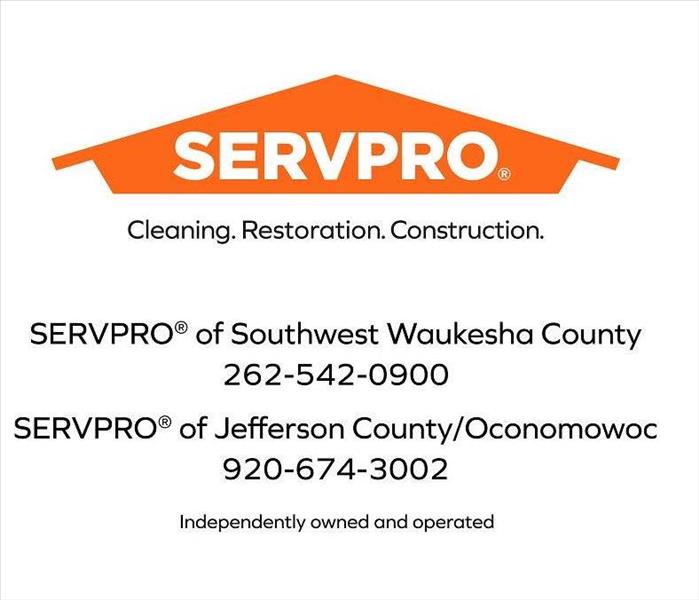 SERVPRO Uses Latest Technology To Dry Structures
SERVPRO Uses Latest Technology To Dry Structures
Why does SERVPRO create environments favorable to drying?
We do this by manipulating temperature and humidity levels with the aid of state of the art monitoring and drying equipment to produce optimum drying conditions.
Psychrometry is the study of the air and its properties. The properties of temperature, humidity, vapor pressure, and dew point are measured to evaluate air conditions in the structure, enabling SERVPRO of Southwest Waukesha County Professionals to create the proper atmosphere for more efficient drying.
Water can damage materials in two ways: first, by absorption through direct contact with water; and absorption of moisture from the air. Measuring the moisture content of the air is critical to the drying process.
Even small water damages from broken water pipes, overflown sinks, and dishwasher or washing machine malfunctions can cause severe structural and indoor air quality issues over time. The key to avoiding costly future restoration is to handle every water problem as a real threat to your property. SERVPRO of Southwest Waukesha County has the equipment, training, and experience to find and dry unseen water before secondary damages occur. The proper equipment makes a measurable difference in reducing the damage expense during a fire or water loss.
When fire and water take control of your life, we help you take it back. Our goal is to make it...”Like it never even happened.”
We are locally owned and operated serving the Waukesha County, WI area. We also live and work in our community and take great pride in living and working here. When fire or water damage takes control of your life, we help you take it back. We are available 24/7 for emergency services to help you regain control quickly. We work with your insurance for a stress-free claims process.
- We are an IICRC Certified Firm
- 5-Star Google and Facebook Ratings
- A+ BBB Rating
- 24/7 Emergency Services
Have Fire Damage, Water Damage, Biohazard, or Mold Damage?
Call SERVPRO of Southwest Waukesha County Today – (262)542-0900
The Do's and Don'ts of Water Damage
11/30/2021 (Permalink)
Do you know the do's and don'ts if you discover what damage is in your home or business?
Here are some tips on what to do if you have a water intrusion
Do: Find the source and shut it off, if possible
Do: Contact plumber or qualified personnel to fix the intrusion source
Do: Shut off circuit breakers to affected areas
Do: Get as much standing water as possible using a shop vac, towels, mops, etc.
Do: Remove furniture and electrical items such as lamps, computers, and TVs
Do: If unable to move furniture, place wood blocks under legs to prevent staining on the carpet
Do: Place a dehumidifier, if possible, to begin to dry out the area
Do: Call SERVPRO and utilize trained water damage technicians to assist you.
Don't: Enter affected rooms with standing water if electrical shock hazards exist.
Don't: Enter affected areas if electrical outlets, switches, circuit breakers, or electrical equipment are exposed to water. Always avoid electrical shock hazards.
Don't: Leave books, newspapers, magazines, or other colored items on wet carpets or floors to cause staining
Don't: Use your household vacuum cleaner to remove water, possibly causing electrical shock or damage to the vacuum cleaner.
Don't: Use TVs or other appliances while standing on wet carpets or floors, especially on wet concrete floors.
Don't: Turn on ceiling fixtures if the ceiling is wet or enter rooms where ceilings are sagging from retained water.
Call on SERVPRO of SW Waukesha County (262) 542-0900 or SERVPRO of Jefferson County/Oconomowoc (920) 674-3002 for all your water damage needs. Speak with certified water restoration technicians who can help you.
Water Loss Prevention - Protect Your Pipes This Winter
11/23/2021 (Permalink)
As the weather gets colder, it is important to get your pipes ready for the freezing temperatures. As water freezes it expands. This can cause pipes to fail and leak. The American Red cross has some helpful tips on how to keep your pipes safe from freezing and/or bursting over the winter.
The Red Cross provided the following tips to keep pipes safe:
- Tightly close doors and windows to the outside.
- Insulate pipes in unheated or drafty areas. Hardware and plumbing supply stores carry insulation to keep pipes from freezing.
- Shut off and drain the pipes leading to outside faucets. Water in these lines can freeze and expand, causing leaks.
- Close the inside valves and drain the pipes leading to your outside hose bibs (faucets).
- Drain the water from swimming pools following the manufacturer’s instructions. Do not put antifreeze in the lines unless directed.
- Know where your main shut off valve is and label it. Minimize the potential for water damage by ensuring that everyone in the household knows how to shut off the water in case of an emergency.
- Open the cabinets beneath any place with a water supply, such as the kitchen and bathroom sinks. This will allow warm air to circulate. Residents with children and pets are reminded to remove any toxic substances first.
- To prevent pipes from freezing, allow one faucet, preferably the one that is the greatest distance from the main water shut off valve, to drip cold water slowly. This does not need to be a running trickle.
- Keep the thermostat set to the same temperature both during the day and at night. By temporarily keeping it warmer at night, you can prevent a costly repair job if pipes freeze and burst.
Remember, if you do have a water loss in your home, we at SERVPRO are here to help you. Our IICRC Water Certified Crew Chiefs are trained and educated in helping you during these hard times. Call us at 262-542-0900 or 920-674-3002.
Oh No!! Frozen Pipes!
11/23/2021 (Permalink)
Now that the weather is getting colder and dropping below freezing, some people may experience frozen pipes. You may notice that little to no water is coming out of the faucet when turned on. There are things that you can and should do at home before calling SERVPRO. The American Red Cross has compiled a list of things to do if you find a frozen pipe in your home or business:
- Identify whether the problem is throughout the house or in one area.
- If the problem is isolated, the pipe may be able to be thawed by opening the cabinets and allowing warmer air to circulate around the pipes.
- You can also use towels soaked in warm water to wrap around the frozen pipes.
- Keep the faucet open. As you treat the frozen pipe and the frozen area begins to melt, water will begin to flow through the frozen area and help melt ice in the pipe.
As a reminder
~ Never thaw a pipe with an open flame. It is very dangerous and can start a fire.
~ Avoid using electrical heaters if there is standing water. This creates fire and electrical shock dangers.
~Keep portable heaters at least 3 feet away from flameable materials (anything that can burn)For all your water damage clean up needs, call SERVPRO at 262-542-0900 or 920-674-3002.
Leave SERVPRO of SW Waukesha a 5-star review
How to Deal with that Gross Smell in your House
5/20/2021 (Permalink)
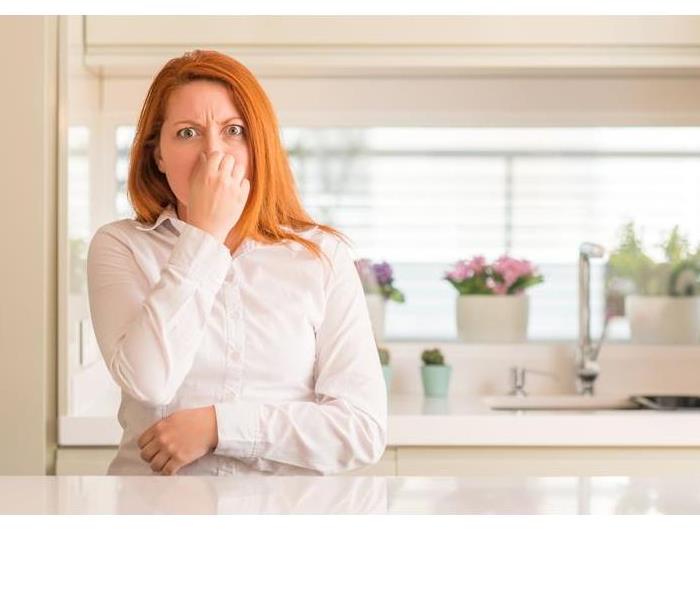 Call SERVPRO of Southwest Waukesha County at (262) 542-0900 to handle all odor problems
Call SERVPRO of Southwest Waukesha County at (262) 542-0900 to handle all odor problems
Fire, mold or pet urine odors are among the top 3 reasons our customers call us. One of the most frequent questions we get asked after an incident that involves odor is "Will it still smell?"
SERVPRO of Southwest Waukesha County deals with odor in various way depending on your specific situation. The process in which we tackle the odor is multi-faceted. It is important to follow the below steps to successfully remove the odor you are dealing with.
1) Analyze the materials that are affected.
2) Remove the source of the odor if possible. This could include removal of fire damaged, moldy, urine affected materials. Carpet, drywall or insulation for example can hold an odor. If those materials are not removed, the odor may still remain.
3) Clean the affected surfaces with the proper chemical(s) to ensure the removal of the odor source.
4) Deodorize the affected area with an ozone treatment if appropriate
5) Follow up with the customer in a few days to confirm the odor has been removed to their satisfaction.
With the steps above being followed, the odor will likely be eliminated and you can get back to living your life without worry.
We take pride in our 90% rate of removing odors from homes and businesses. If you have an odor concern, please call us for a walk through of your structure to evaluate how we can help.
Call SERVPRO of Southwest Waukesha County at (262) 542-0900 to handle all odor problems
How to Prevent Potential Flooding this Spring
4/8/2021 (Permalink)
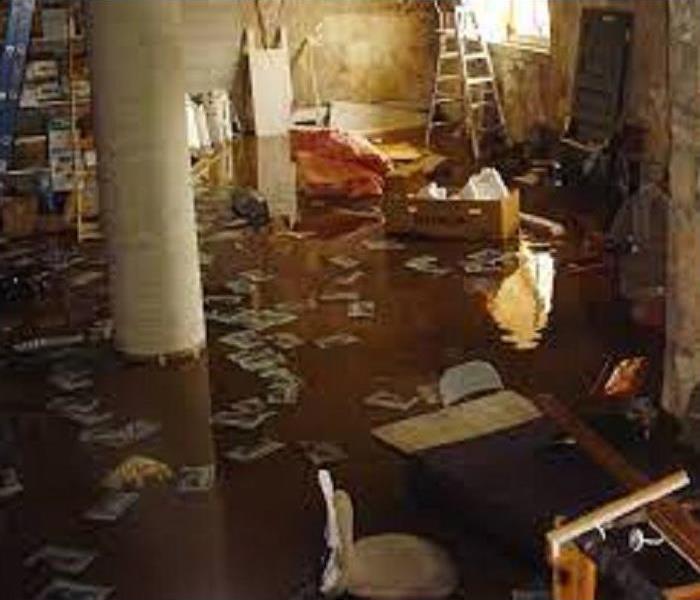 Call SERVPRO of Southwest Waukesha County to help handle all flooding damage.
Call SERVPRO of Southwest Waukesha County to help handle all flooding damage.
As is the danger in every spring flooding is always a possibility as the snow melts and the spring showers roll around. Flooding is very dangerous for all homeowners if they are not properly equipped to handle the flooding. There are many different ways that you can handle flooding, but it is most important to know how to prevent it, and what actions you can take if you still experience flooding.
Preventative Measures
- Apply coatings and sealants. A form of "dry flood-proofing," coatings and sealants that you apply to your foundation, walls, windows and doorways help prevent flood water from leaking into your house through cracks.
- Raise your electrical outlets and switches. All outlets, switches, sockets and circuit breakers should be at least one foot above flood level to avoid significant electrical damage in the case of a flood.
- Install check valves on your pipes. Make sure that all pipes entering your house have valves to prevent a flooded sewage system from backing up into your home. Gate valves are preferred over flap valves, since they provide a better seal against flood pressure.
- Grade your lawn away from the house. If your lawn tilts toward your house, rainwater will pool around your home. Use a heavy soil that contains clay and sand to regrade your lawn so that surface runoff empties into an appropriate place, such as a street gutter.
- Leave space between mulch and siding. Wet mulch can rot your house's siding, which in turn can lead to leaks. Keep space between your mulch and siding so that the base of your house can completely dry after rainstorms.
- Point your downspouts away from your home. If your gutter runoff is not pointed away from your house in an appropriate direction, it can pool at the corners of your house and may eventually create leaks in your basement.
However these preventive steps are not full proof, and it is important to know how to handle flooding if it does occur.
How to Stop Flooding Once it Starts
- Turn off the water line, if that is the source of the flooding.
- Clear out gutters and drains so that water can flow freely.
- Use sandbags to block any gaps that will lead to flooding.
- Move rugs, furniture, electronics and other valuables to a higher floor of the home, or elevate them.
- Shut off your electricity at the breaker panel, if flood water is close to reaching your electrical system.
- If it's not raining, open windows to allow air flow through your home.
- Turn on your sump pump or use a shop vacuum to remove water as quickly as possible.
These measures will help minimize the damage that the flooding can cause.
For any flooding and water damage Call SERVPRO of Southwest Waukesha County at (262) 542-0900
Do's and Don'ts of Replacing Hardware
3/23/2021 (Permalink)
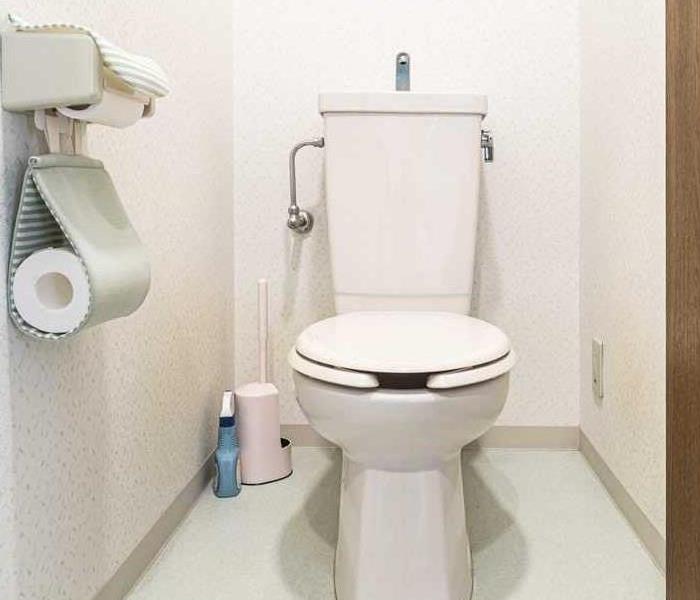 Remember to take caution when changing pipes and other hardware
Remember to take caution when changing pipes and other hardware
Everyone gets excited about updating the appliances in our house. However, a lot of us forget that we must also replace the hardware that goes along with our new appliances. If you have not replaced this equipment recently, it is recommended to replace the water supply lines every 5 to 8 years. Tubes, rubber and plastic connectors break down and wear out over time. Just like on your car or even your lawn mower, these require maintenance and repairs in order to avoid major water losses.
Please follow these tips when changing a supply line in your home or business.
Before you do anything, SHUT OFF your water supply.Turn your water supply valve to the right until it’s tight, then flush your toilet and tank or lines to drain out the water. If you do not have a water supply shut-off valve, contact a local licensed plumber to install one. If you don’t remember to flush the toilet, you could end up dumping a bunch of water all over your bathroom floor later on the in the process. Also, it may be a good idea to soak up all the water that has leaked out onto your floor if you haven’t already. Bathroom floors can be slippery when wet.
Remove the old supply line. Use a wrench and loosen the hex-nuts that connect the supply line and remove.
Replace the line. With your new supply line attach one of the ends. It doesn’t matter which end you choose to install first. Line it up and use your fingers to tighten the hex-nut into place. Now, attach the opposite end and use your fingers to tighten the hex-nut into place. Then take a wrench to tighten the hex nut.
Turn the water back on. Now that your supply line is in place, you should be good to go to turn your water source back on. SLOWLY turn the supply valve to the left until you start to hear water running, just be sure to be cautious of any leaks.
If you attempt to replace the hardware on your own and something goes wrong, Call SERVPRO of Southwest Waukesha County for all your water damage clean-up needs. (262) 542-0900.
How SERVPRO of Southwest Waukesha Deals with Water Damage
3/23/2021 (Permalink)
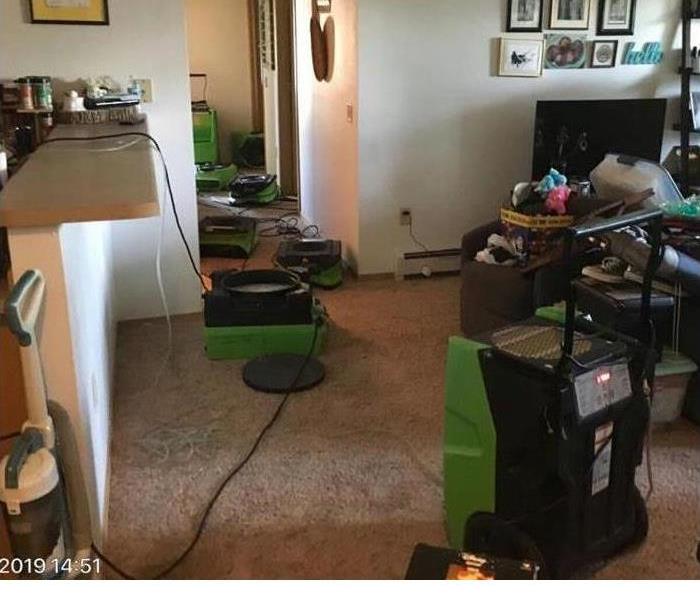 Call SERVPRO of Southwest Waukesha for all Water damage needs
Call SERVPRO of Southwest Waukesha for all Water damage needs
SERVPRO crews implement a course of action for restoring a property that has water damage. A quick response is key to preventing further water damage.
There are five fundamental principles for water damage restoration which are noted in The Institute of Inspection, Cleaning and Restoration Certification (IICRC) S500 Standard and Reference Guide for Professional Water Damage Restoration:
- Mitigation
- Drying Plan
- Cleaning and Repair
Safety is the primary concern on a job site. It is important to make sure the crews and the occupants are informed and protected from any safety issues.
Documentation is important to create an action plan for the project. At SERVPRO we use DryBook which is used on iPads that the crews bring on every job. Using DryBook helps our crews document everything that is happening on the job, how to create a drying plan and to make sure the structure is drying properly.
Mitigation is important because it helps the occupant recover more quickly from the water loss event.
Drying plan includes removing excess water, extraction, evaporation and dehumidification. Drying equipment is placed to remove moisture through evaporation and dehumidification. Temperature is also important to increase the rate of evaporation.
Cleaning and repair are done when the drying plan is complete and drying goals have been met. This is to repair and clean the property to preloss condition.
For all Water Damage needs call SERVPRO of Southwest Waukesha at (262) 542-0900
Frozen Pipe Prevention
2/5/2021 (Permalink)
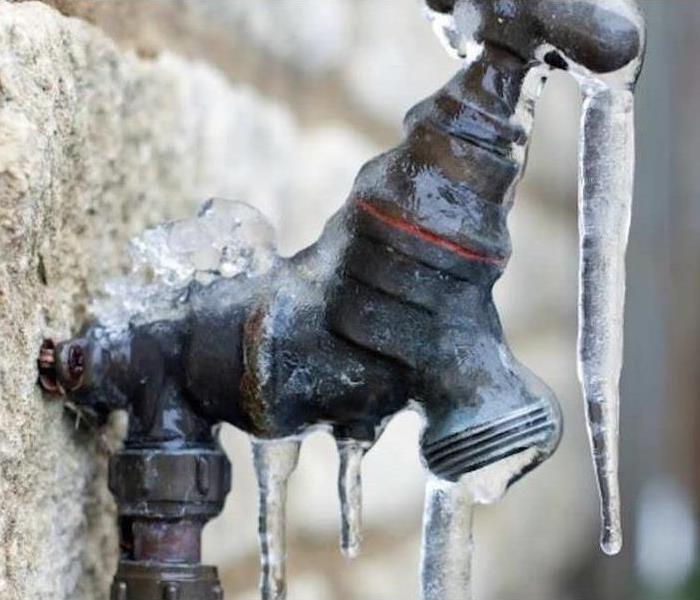 Frozen Pipes Often Lead to Structural Damage Inside
Frozen Pipes Often Lead to Structural Damage Inside
Winter months lead to emergency water losses caused by frozen pipes that burst. The following are six helpful tips to help combat the cold this winter:
1. Keep Water Faucets Running
If it is extremely cold outside, always keep one or two faucets running, very slowly. Water moving through the system should prevent the line from freezing.
2. Disconnect Your Hose From The Outside Faucet
Be sure to disconnect your hose from the outside faucet. If you leave your hose connected, water is not able to drain out of your hose bib which can cause it to break.
3. Turn The Water Off To The Outside Faucet
4. Install Heat Tape
Heat tape is a great tool to use when it is extremely cold. Homeowners can install this tape themselves and it will warm pipes as needed during cold weather.
5. Seal Leaks That Allow Cold Air Into Your Home
Look for air leaks around electrical wiring, dryer vents, and pipes. Use caulk or insulation to keep the cold out. With severe cold, even a tiny opening can let in enough cold air to cause a pipe to freeze in your home.
6. Check Your Home's Temperature
Prevent temperatures from dropping below 32 degrees in any area of your home where water lines are located.
The certified water restoration technicians at SERVPRO of Southwest Waukesha are help you with all of your emergency water damage needs, particularly ice dams and melting snow. Call (262)542-0900 and speak with a trained water restoration technician!
SERVPRO Helps Flooded Tri-Level Home
1/29/2021 (Permalink)
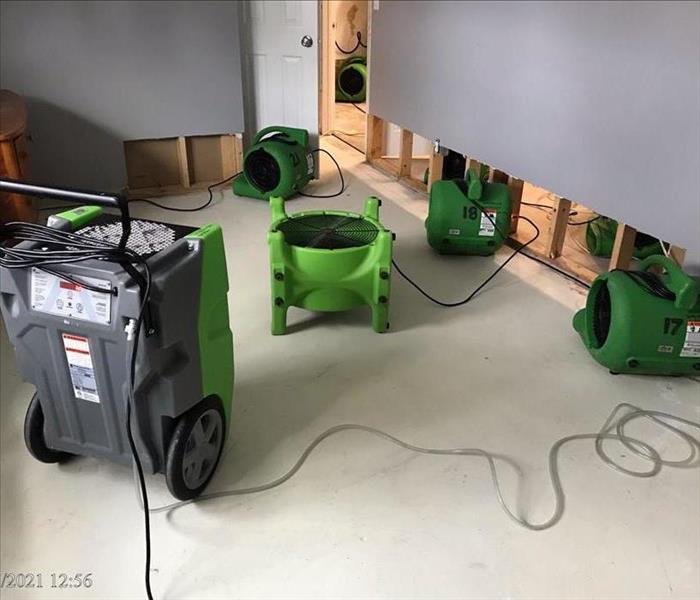 Proper Drying Equipment Placed After Water Damage
Proper Drying Equipment Placed After Water Damage
A backed-up sewer line caused this tri-level basement and attached garage in Waukesha, WI to flood. Due to the graphic nature of this loss, we are showing this picture which is what the recreation room looked AFTER the contents were moved out, the laminate floor removed, the contaminated drywall wall cut out and the floor cleaned and disinfected.
When a sewage back-up occurs, anything that is porous (soaks up moisture) must be considered non-salvageable. Non-porous materials (such as plastic) can be cleaned and disinfected as well as structural items that can not be removed. If this contamination is not removed and the structure disinfected, it could lead to people getting sick.
Contact SERVPRO of SW Waukesha County for all your water damage and sewage back-up needs. We have certified water restoration technicians available to assist you to make sure that your home or business is cleaned and disinfected properly. 262-542-0900.
SERVPRO of South West Waukesha County is A IICRC Certified Restoration/Mitigation Company. What Does That Mean?
12/18/2020 (Permalink)
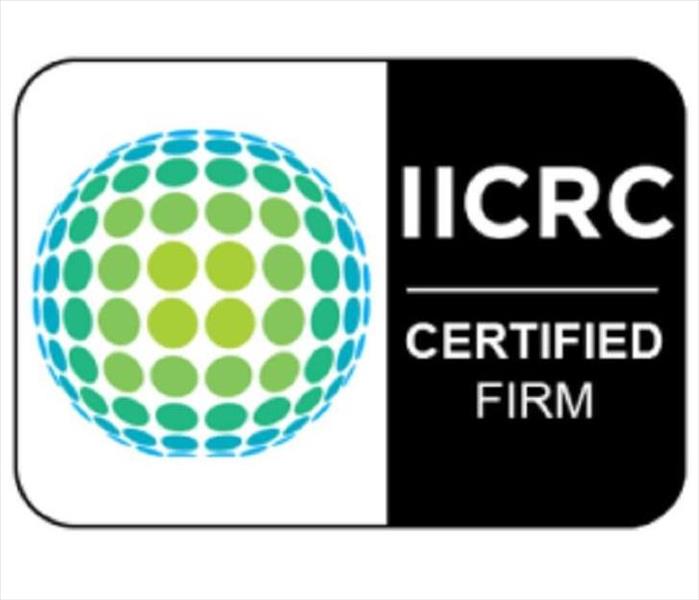 SERVPRO has been trusted by many, not just because we are IICRC certified, but it sure does help impress!
SERVPRO has been trusted by many, not just because we are IICRC certified, but it sure does help impress!
In the 1990s and early 2000s, restorative drying science was in its infancy but was evolving as some leaders in the restoration industry began taking a more scientific approach. Restorers were rapidly becoming restoration specialists, and in the process, they were learning what worked and what did not work. Those restorers worked to understand the science that impacted their business and developed the technology still used today.
As restorer confidence began to grow, the training needed to grow as well. The term Applied Structural Drying (ASD) became known in the industry as a drying course. The Institute of Inspection, Cleaning and Restoration Certification (IICRC) stated in its IICRC S500 V3-2006 standard, “Currently, among the IICRC’s 38,000 registered technicians, approximately 24,000 are IICRC-certified as Water Restoration Technicians (WRT), with approximately 4,500 of those being certified in Applied Structural Drying (ASD). This number is growing daily. ASD is primarily a hands-on course in which demonstration houses representative of standard residential construction are flooded, extracted, monitored, and dried throughout the three-day course – although three-day drying cannot be guaranteed.”
Everyone was going to these classes, from contractors to adjusters to property managers. The fact that a restorer could reduce the cost of rebuilding a structure substantially impacted the bottom line of the final customer, reduced cycle time, and decreased rebuild costs.
The untold truth was that even with a sanitary environment with limited contents, more than enough power and with known quantities, known saturation times, and a repeatable process, these buildings still required additional days to dry.
Some contractors and adjusters believe contractors are in possession of technology, equipment, and training that can dry structures in three days. The fact remains that these sceptics are hard pressed to substantiate their comments. Moreover, publishing erroneous materials can lead to serious conflicts between contractors and adjusters rather than assist in fair and scientifically sound practices.”
Drying Science in 2020
In 2020, the science has evolved, the equipment has evolved, and restorative techniques have dramatically improved. But with all this improvement and knowledge one thing is true – three-day drying is not the norm. Stephanie Beattie of the Center for Disaster Recovery in Barrier, Ontario stated the best statistics show we went from an average of 6.2 days in 2016 to 4.9 day in 2018.
There has been plenty of research by the restoration community and building science (engineers) community to substantiate the fact that not all materials can be dried in a specified, arbitrary time of three days. As a matter of fact, many structural materials will dry in varying degrees, depending on saturation time, atmospheric conditions, and the material’s location in the building composition.
For the most part, today’s insurance adjusters do not look at the goal of the drying project; they look at the costs of the job. The measurable cost of the job is more important than the successful drying of a project. But are those clients saving money? Did you help them understand the true savings?
Today, the indoor environmental profession knows more about the effects of contaminated indoor environments and the effects of mold on occupants and highly sensitized individuals. If contractors and their customers are not aware of these risks and do not address properly drying a structure, it can dramatically increase the potential for litigation and there is no limit on that liability.
SERVPRO of Southwest Waukesha is an IICRC Certified Firm. Contact us for all your water damage needs or inquiries. 262-542-0900
What Are The Most Common Causes Of Water Damage? Well, Here's What We See Here At SERVPRO
11/24/2020 (Permalink)
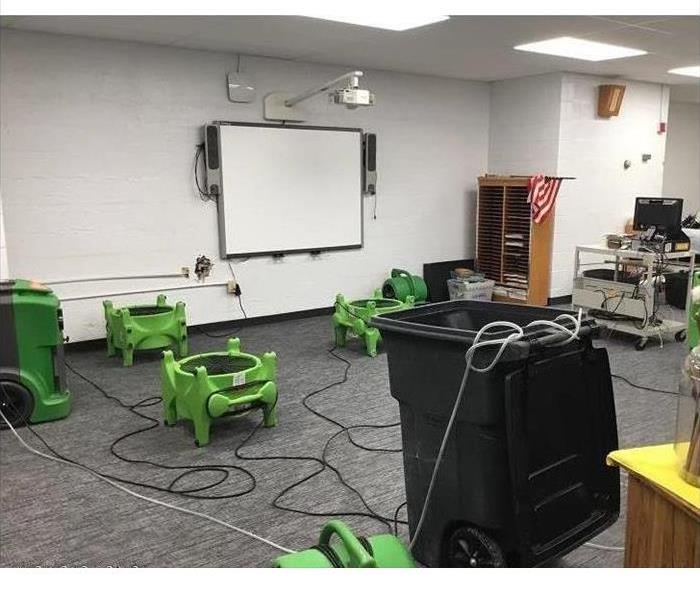 SERVPRO was recently called out to a Waukesha School District building for a water loss. Our certified technicians made sure the building was safe!
SERVPRO was recently called out to a Waukesha School District building for a water loss. Our certified technicians made sure the building was safe!
When a person thinks about water damage, they often think of severe weather conditions. However, there are many other items in your home or business that may be a cause of water damage. Water damage is something that many homeowners will face.
There is a significant difference between water damage and gradual water damage, which has an impact on homeowner’s insurance claims. Examples of gradual damage are circumstances that have been happening over time, like plumbing issues in the walls causing damage to the walls, ceilings or floors, or water damage caused by cracks in the foundation. Unfortunately, many gradual water damage issues are not covered by homeowners insurance, while storm-related water damage usually is.
According to the Insurance Institute for Business & Home Safety (IBHS), the leading causes of water damage are:
- Plumbing supply system failures. This involves frozen pipes that can burst because the water pressure builds up due to freezing water in the pipes or when the supply system materials fail, causing pipes to leak or burst. They also found that homes with ages of 16 to 40 years made up a larger portion of supply system material failure claims.
- Plumbing drain system failures. This can occur when a sewer drain backs up and overflows into a home, or from material performance issues.
- Toilet failures. Toilets cause the second highest number of residential water damage losses after plumbing supply system failures and are the result of faulty fill valves or clogged drain lines.
- Water heater failures. If your water heater has reached its life expectancy, the tank begins to rust and corrode, which can result in leaking or bursting issues.
- Washing machine failures. These are typically caused by supply hose failures, machine overflows and drain line failures.
If your home or business has experienced water damage, call SERVPRO of SW Waukesha County at 262-542-0900
Keeping Your Plumbing Safe While You're Away From Home
11/13/2020 (Permalink)
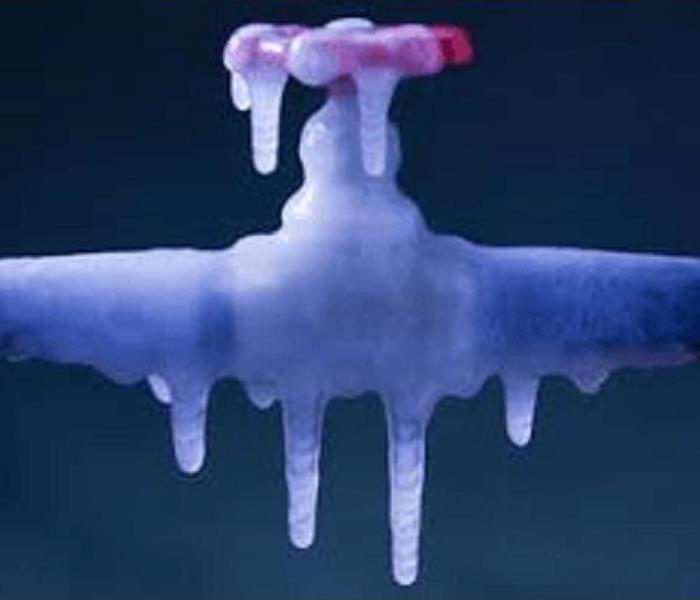 If you leave and come back to a mess, give us a call! 262-574-0900
If you leave and come back to a mess, give us a call! 262-574-0900
Anyone that has lived in Wisconsin knows how brutal our winter months can be. We all look forward to vacations to escape the cold weather and dreary days. However, before you leave for that vacation you have been patiently waiting for, be sure to protect what is probably your biggest asset, your home. Many times each year SERVPRO of SW Waukesha County is called to properties during the winter months that were not properly prepared for the cold weather before the occupants left. Please read the other blog about Tips to Prevent Pipes from Freezing, but the following are tips to follow before going on that vacation.
WAYS TO AVOID FROZEN PIPES WHILE ON VACATION
- Set the thermostat in your house no lower than 55 degrees Fahrenheit
- Be sure to replace the battery in your thermostat
- Ask a friend or neighbor to check your house daily to make sure it is warm enough to prevent freezing
- Shut off the main water supply and drain the water system. (Be aware that if you have a fire protection sprinkler system in your house, it may be deactivated when you shut off the water)
Please call SERVPRO of SW Waukesha County with any water damage needs this winter and beyond. 262-452-0900
SERVPRO Successfully Dries Ceramic Tile Flooring
10/14/2020 (Permalink)
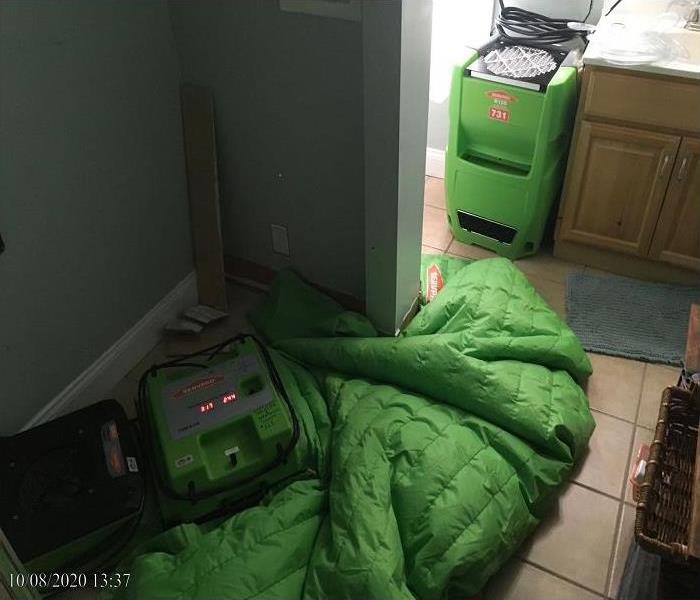 SERVPRO's Drying Equipment In Action To Dry Ceramic Tile
SERVPRO's Drying Equipment In Action To Dry Ceramic Tile
An overflowing wash machine caused this laundry room to flood. The water migrated through the ceramic tile floor and into the den below.
SERVPRO of SW Waukesha County was called in to dry out the structure and do as little demo as possible. We knew that it would be a challenge to dry out the ceramic tile floor, but with the proper equipment, we had a chance of success.
This photo shows our heatable mat system and dehumidifier in place. This equipment works by placing a standard air mover with the air blowing into a heater to warm up the air. This heated air is then blown into an inflatable mat that has tiny holes on the bottom where the hot air can escape. The hot air comes in contact with the ceramic tile heating it up while removing the moisture at the same time. The average drying time for this type of work takes about 3 days, but this one took 4 days. It was one extra day of drying but it prevented the entire floor from having to be removed and replaced, saving the insurance company a significant amount of money.
Call SERVPRO of SW Waukesha County with all your emergency water restoration needs. 262-542-0900
Mold Is Dangerous Even Beyond Containment
9/28/2020 (Permalink)
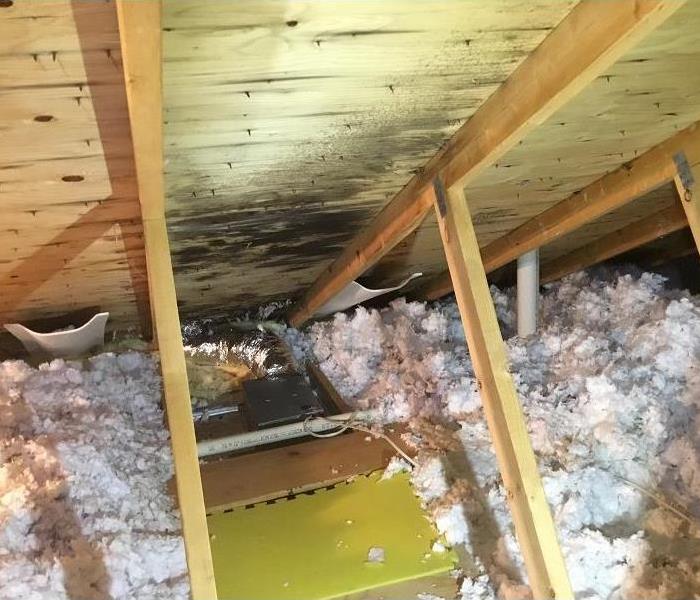 Black Mold Inside Structures Can Make Air Quality Dangerous
Black Mold Inside Structures Can Make Air Quality Dangerous
Containment in remediation protocols is a restoration industry staple. But all too often mold specialists are missing the point and failing to be effective in their containment efforts.
Many of the traditional protocols and methods currently associated with, what may be termed as “traditional mold remediation methods”, were borne from the asbestos abatement industry. Once a problem area is identified, one of the first steps is to set up containment around the affected area.
This is entirely appropriate and necessary for asbestos work as the harmful by products of the abatement do not become airborne until after the containment is set up and the remediation has begun.
However, mold is a different beast. It is a living organism. As such, it is actively seeking to expand its environment beyond its present location. As remediators, we may conscientiously set up containment around a visible mold bloom the moment we step onto the jobsite. But long before our arrival our musty friend has been hard at work (often times with the help of we humans) sending its spores throughout the building environment, potentially starting new colonies in unseen locations and most assuredly compromising the quality of the building’s breathable air supply. Therefore our true containment in an effective mold remediation is the entire building envelope, not just the immediate area or room where we have visible growth.
Keep in mind that many contractors would have been content in merely treating the area within containment, and no doubt would have passed any Industrial Hygienist written protocol or post remediation testing. But the real culprit, the air borne spores that had already spread throughout the building envelope, would have been left behind to create further havoc. One additional step to remediate the problem is to have those air ducts clean and deodorized.
Please give us a call for any mold or asbestos needs at 262-542-0900. SERVPRO of SW Waukesha County has certified technicians in both areas so don't hesitate to get in contact with us.
Source:
https://www.randrmagonline.com/
Desiccant Dehumidifiers Are Essential Equipment at SERVPRO To Properly Dry Out Structures
9/11/2020 (Permalink)
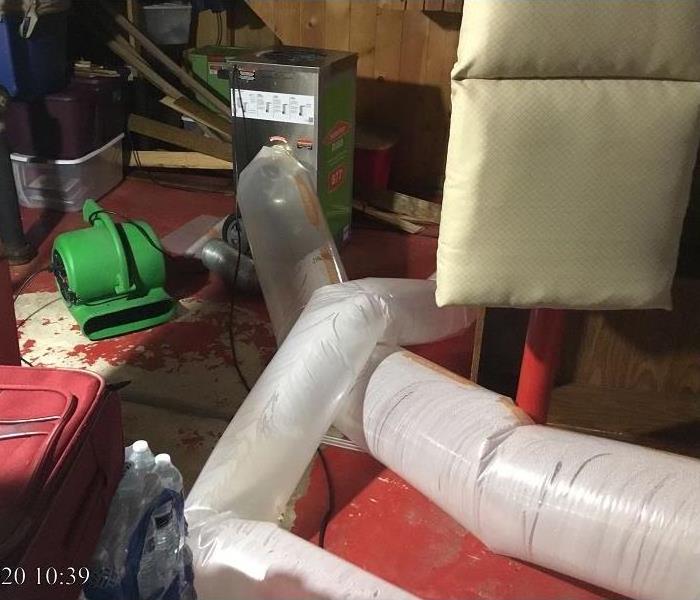 Desiccant Dehumidifier In Action
Desiccant Dehumidifier In Action
At SERVPRO of SW Waukesha County, we utilize the latest and/or greatest technology and equipment that will help us dry out structures as quickly as possible, based on the particular need of that structure. Other than standard low-grain refrigerant (LGR) dehumidifiers, we also use desiccant dehumidifiers. People often ask us "What is a desiccant?"
- A Desiccant dehumidifier is similar to a standard grade dehumidifier in the sense of they both bring down moisture levels in a contained structure. However, a desiccant is very different in the process they use to remove the moisture. Desiccants can be the same size as an LGR dehumidifier but as big as a semi-trailer. Desiccants have a unique ability to dry air that is actually already quite dry. These machines can also dry the air in extremely difficult to dry materials, even at below 60 degree temperatures (were a standard grade or LGR dehumidifier would go into defrost mode). Desiccant dehumidifiers are a very useful tool in our SERVPRO inventory. With our Franchise being located in Wisconsin, about half our year is under 60 degrees.
What is the difference in a Desiccant vs Standard dehumidifier?
- A standard grade dehumidifier (also known as a compressor based dehumidifier) uses a compressed refrigerant to cool metal coils (evaporator coils). The humid air that enters the dehumidifier condenses on these cool coils. This leaves the air that exhausts out of the dehumidifier warm and drier than when it entered. Desiccant dehumidifiers work quite differently. Instead of using condensation on cold evaporator coils to remove humidity from air, desiccant dehumidifiers use a chemical called a desiccant to do so. The chemical in our desiccants once heated release the moister air into a condensed form so they can be purged or ran through a LGR dehumidifier for better efficiency.
Why would SERVPRO use a desiccant in my home or business? There are three reasons
- Ambient air temperature. As I wrote earlier, our standard LGR dehumidifier have a hard time running at their max efficiency below 60 degrees an ambient air temperature. Now in most cases we can bring in portable electric heating or turn up the heat of the house or structure to get us in the range were a LGR could run at their full potential. But what happens when we can't bring in temporary heat or turn up the furnace? This is when we would run a desiccant dehumidifier; to begin drying out the structure until we were able to bring the heat up to an appropriate level.
- Size of the affected area of water damage. In some commercial situations or large residential homes and garages we are always trying to get our drying process done as thoroughly and quickly as possible. In these cases, running multiple LGR dehumidifier and air movers may not be enough or the most cost effective way to dry a structure out in a timely manner. This is when we start to think about desiccant dehumidification.
- Saturation of structure. This bring us back to drying in a timely manner. If structural building materials have reached their max saturation, and have remained at that level for some time, the materials become harder to dry out and bring them down to drying goals. These instances are perfect opportunities to build temporary containment chambers and run our desiccants to dry things thoroughly and quickly.
In this photo, you will see the plastic ducting connected to a desiccant dehumidifier. This ducting is vented to the outside which is where we want the moist air going. If you look closely, you will see the moisture that condensed on the inside of the ducting. This is proof of the machine doing its job. The air mover next to the desiccant is used to help circulate the air to evaporate the moisture into the air.
Do not hesitate to give us a call at 262-542-0900 with any questions regarding the equipment that we use of if you need our assistance in drying out a structure. No matter if it is residential or commercial, big or small, SERVPRO of SW Waukesha County has the correct equipment and certified trained technicians to properly dry out your structure. thing else). We are always here to help.
SERVPRO of SW Waukesha - Going the Extra Mile
4/30/2020 (Permalink)
 Drying equipment setup in the kitchen after mitigation.
Drying equipment setup in the kitchen after mitigation.
SERVPRO of Southwest Waukesha is proud when we get calls from repeat customers! Even though we understand most people don't want a disaster in their home or place of business, we appreciate the fact that customers call us back when disaster strikes more than once to use our services.
This job in Fort Atkinson, Wisconsin was a customer who used our services in 2019 for a broken pipe. He was so happy with our service that when he moved into a new home in 2020 and when he had another sewage back up, he called us again. Nothing makes us happier than being able to provide exceptional customer service! A repeat customer shows that SERVPRO goes the extra mile to make sure our customers get the great service they deserve.
Thank you to the many customers that continue to contact us for each unfortunate incident. We appreciate you!
If you have any type of water damage, please call the professionals at SERVPRO Southwest Waukesha. Speak to a certified technician today! 262-542-0900.
Drain Backup in Helenville, WI
4/16/2020 (Permalink)
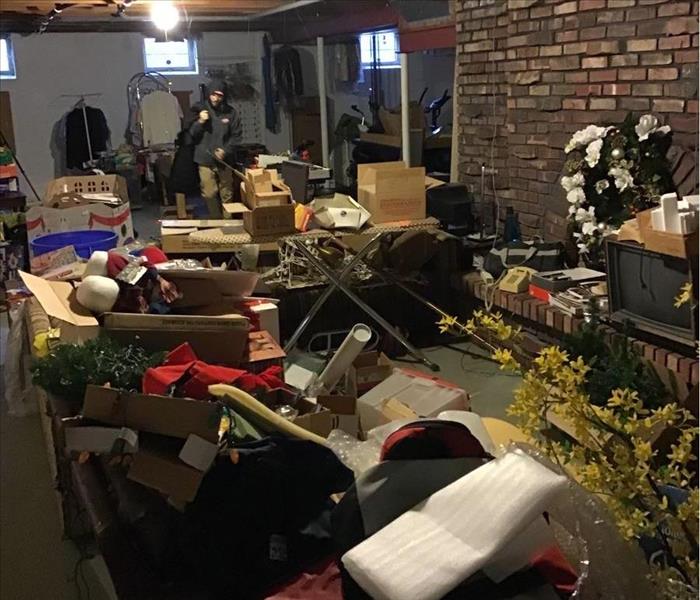 SERVPRO moves and cleans content as well as structures when mitigating a water loss.
SERVPRO moves and cleans content as well as structures when mitigating a water loss.
SERVPRO of SW Waukesha takes pride in helping people. During a recent sewage drain back up at a property in Helenville, WI, we helped with both removal of contaminated water clean up and reorganizing our customer's basement.
It is priority for SERVPRO to be thorough when we are cleaning up after an emergency water/sewage back up. We want to make sure to clean every contaminated area and salvageable content properly.
Often times when water losses occur in basements, we find unorganized personal belongings that have been placed haphazardly over time. These items may have come in contact with the contaminated water. If that is the case, it requires our crews to move and rearrange the customer's belongings. We will take the time to go through the belongings and ensure they are completely cleaned and disinfected if they were affected. We work directly with the homeowner to recommend if any items should be cleaned or possible disposed of if the contamination is too excessive. Once we are ready to put disinfected belongings into a clean area, that is when our customer benefits from us helping move and reorganize long forgotten items. This service is included with most insurance claim jobs.
Just another reason SERVPRO service standards shine above and beyond competitors. We provide complete services with extra perks that we are proud to offer our customers.
For any emergency water damage or sewer backups, please call the certified water restoration technicians at SERVPRO of SW Waukesha. 262-542-0900
Visit us on Facebook, Twitter, LinkedIn, and Instagram!
Water Damage and Baseboards
3/4/2020 (Permalink)
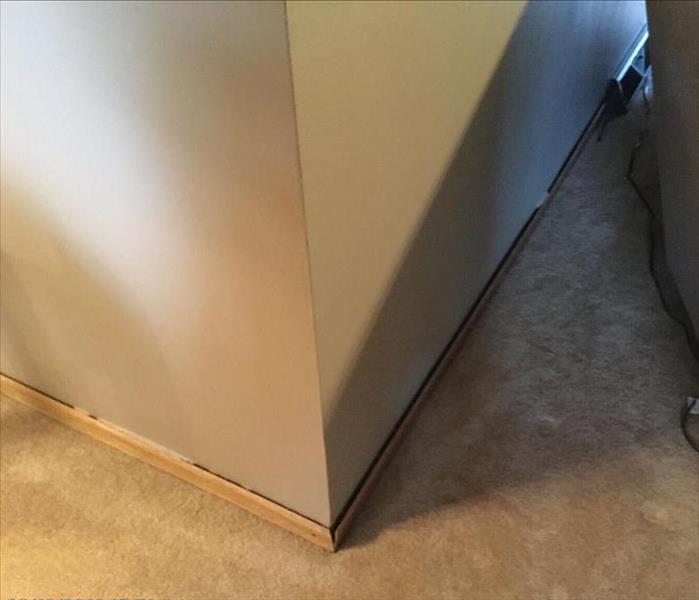 Baseboards separating from the wall can be an indicator of water damage.
Baseboards separating from the wall can be an indicator of water damage.
SERVPRO of Southwest Waukesha has been called out to water losses and we need to determine the extent of the damage and what materials are affected. The photo shows some baseboard separation from a wall. This is a good indicator that there could be water damage affecting the specific wall. In this case, there was a fridge line that had leaked on the opposite side of the wall and the water saturated the wall causing the baseboards to shift away from the wall. Saturated drywall becomes soft and no longer holds the nails in place that were used to attach the baseboards to the wall. When this occurs, the baseboards are completely removed from the wall and inspected for mold growth. In most cases a flood cut is then performed to remove the affected drywall and expose the framing. The framing can then be properly dried before the drywall is replaced.
For any questions regarding water damage, mitigation, or cleanup please call us at (262)542-0900 today!
Water Extraction in an Unfinished Basement
3/2/2020 (Permalink)
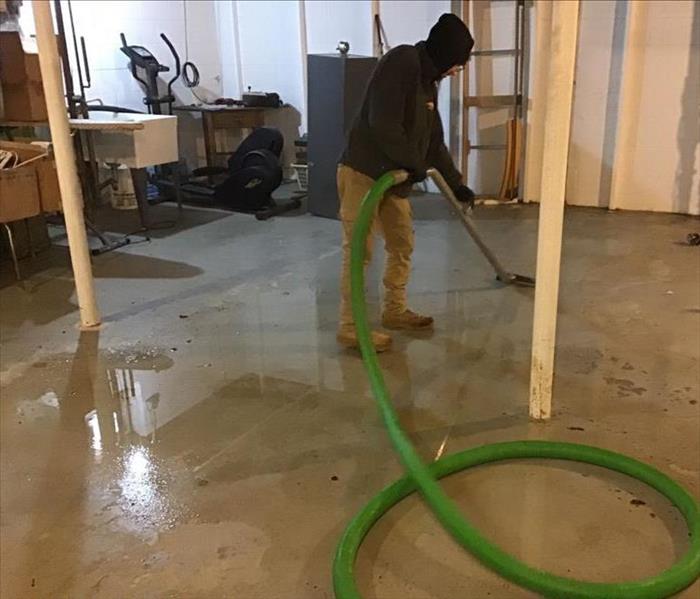 This technician is extracting excess water from an unfinished basement.
This technician is extracting excess water from an unfinished basement.
When SERVPRO of Southwest Waukesha gets called to an emergency water loss, sometimes we need to extract excess water from various surfaces. Most commonly used attachment to the extractor is the wand, in this case it is a hard surface wand. The wand is attached to the extraction hose and attached to a truck mounted extractor.
In this photo, a technician is extracting the excess water from a basement with a recent water intrusion. After the technician extracts the excess water, drying equipment is placed. Industrial grade dehumidifiers and air movers are used to return the affected materials to their normal saturation levels.
The certified water restoration technicians are available at SERVPRO of SW Waukesha County to help you if you experience water damage. Call us today at (262)542-0900!
Tips to Prevent Frozen Pipes
2/14/2020 (Permalink)
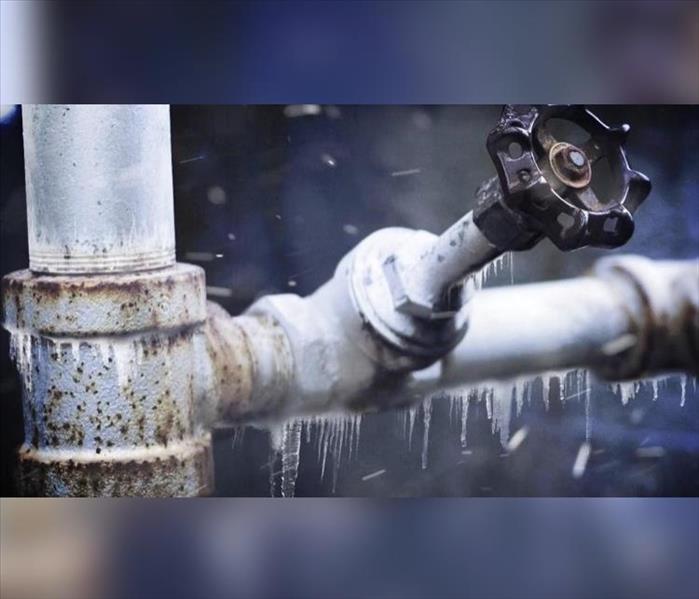 Frozen pipe
Frozen pipe
Our long, cold and dreary Winter months lead to many emergency water losses caused by frozen pipes that burst. As a general rule of thumb, in order for your home's water pipes to freeze, the outside temperature needs to be below 20 degrees, for a total of at least six consecutive hours. The following are some helpful tips to help combat the cold this winter:
1. Keep Water Faucets Running
If it is extremely cold outside, always keep one or two faucets running, very slowly. Water moving through the system should prevent the line from freezing.
2. Disconnect Your Hose From The Outside Faucet
Be sure to disconnect your hose from the outside faucet. If you leave your hose connected, water is not able to drain out of your hose bib which can cause it to break.
3. Install Heat Tape
Heat tape is a great tool to use when it is extremely cold. Homeowners can install this tape themselves and it will warm pipes as needed during cold weather.
4. Seal Leaks That Allow Cold Air Into Your Home
Look for air leaks around electrical wiring, dryer vents, and pipes. Use caulk or insulation to keep the cold out. With severe cold, even a tiny opening can let in enough cold air to cause a pipe to freeze in your home.
5. Check Your Home's Temperature
Prevent temperatures from dropping below 32 degrees in any area of your home where water lines are located.
The certified water restoration technicians at SERVPRO of Southwest Waukesha are help to help you with all of your emergency water damage needs. Call (262)542-0900 and speak with a trained professional who can help!
Powering Our Drying Equipment
1/31/2020 (Permalink)
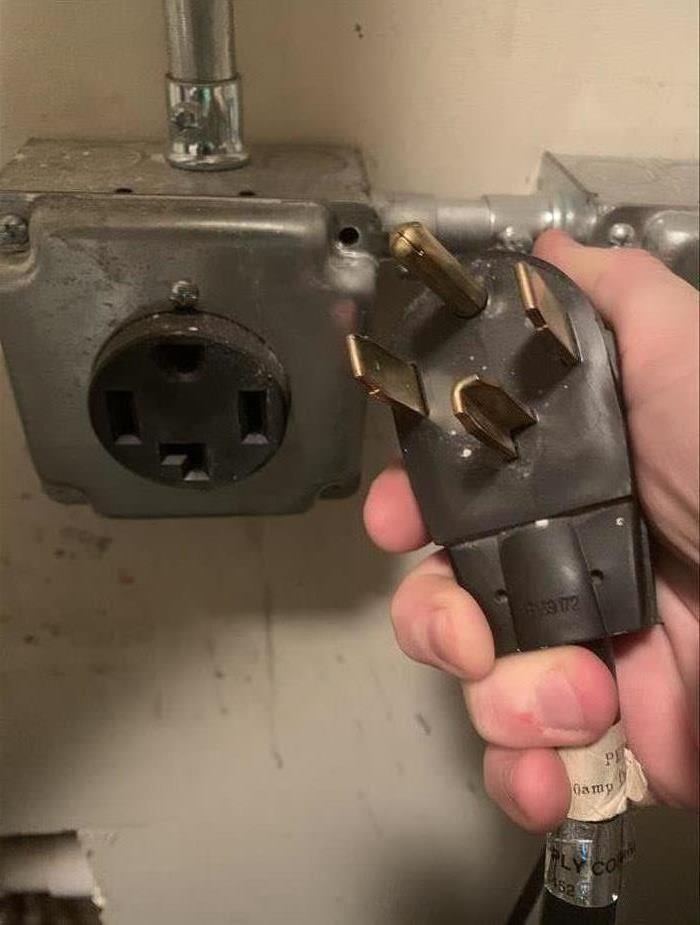 A dryer outlet could be used for additional power for drying equipment.
A dryer outlet could be used for additional power for drying equipment.
When SERVPRO of Southwest Waukesha gets called out to an emergency water loss, the first thing we do after meeting the property owner is to do a complete and thorough walk-through or scope of the property to assess the extent of the damage. Then, it is time for our team to develop a drying plan. Our crew chiefs will need to account for what kind of materials are affected, potential safety concerns, and what kind of equipment will be the most effective to dry properly. We have industrial grade dehumidifiers, air movers, and axial fans that we use to facilitate the drying wet materials. In addition, we may use several other types of equipment depending on the type of job, air scrubbers, hydroxyl machines, and power distribution units are some of specialty equipment we use. Many homes only support either 100 or 200 amps when it comes to available power. What do we do if our team needs additional power to run more equipment? There are 2 options that we typically utilize:
1. We can potentially use an existing electric dryer or stove outlet, like the one seen in the photo, to allow us to setup a power distribution unit. We can plug our equipment into this unit to allow us to use an additional 50 amps of power. This option is most common and these power distribution units are always on our trucks to ensure our team can deploy this option quickly and efficiently.
2. We may call in a licensed electrician to install a temporary power panel to allow our team of professionals to place more equipment in the home. This option is perfect for large losses that have multiple levels affected or that have many rooms affected.
Call us at 262-542-0900 for all your water damage clean-up needs!
Replacing hardware is an essential part of being a homeowner
12/26/2019 (Permalink)
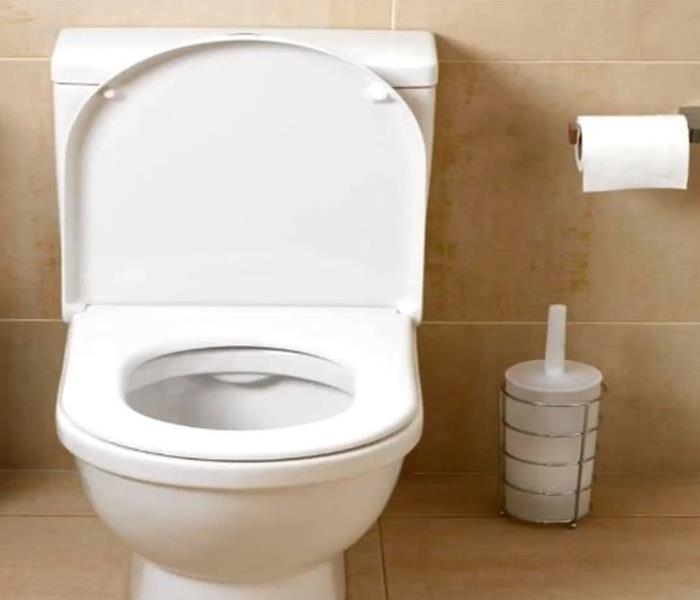 It is recommended that your water lines be replaced every 5-8 years. Call SERVPRO of Southwest Waukesha for all of your water damage clean-up needs
It is recommended that your water lines be replaced every 5-8 years. Call SERVPRO of Southwest Waukesha for all of your water damage clean-up needs
Each time you get a new appliance, you may just be thinking of how excited you are to install. A lot of us forget that we must also replace the hardware that goes along with our new appliances. If you have not replaced this equipment recently, it is recommended to replace the water supply lines every 5 to 8 years. Tubes, rubber and plastic connectors break down and wear out over time. Just like on your car or even your lawn mower, proper maintenance and preventative care is a necessity to avoid a water loss.
Please follow these tips when changing a supply line in your home or business.
Before you do anything, SHUT OFF your water supply.Turn your water supply valve to the right until it’s tight, then flush your toilet and tank or lines to drain out the water. If you do not have a water supply shut-off valve, contact a local licensed plumber to install one. If you don’t remember to flush the toilet, you could end up dumping a bunch of water all over your bathroom floor later on the in the process. Also, it may be a good idea to soak up all the water that has leaked out onto your floor if you haven’t already. Bathroom floors can be slippery when wet.
Remove the old supply line. Use a wrench and loosen the hex-nuts that connect the supply line and remove.
Replace the line. With your new supply line attach one of the ends. It doesn’t matter which end you choose to install first. Line it up and use your fingers to tighten the hex-nut into place. Now, attach the opposite end and use your fingers to tighten the hex-nut into place. Then take a wrench to tighten the hex nut.
Turn the water back on. Now that your supply line is in place, you should be good to go to turn your water source back on. SLOWLY turn the supply valve to the left until you start to hear water running, just be sure to be cautious of any leaks.
If for whatever reason your husband was not able to read these directions carefully, and you end up needing help… Call SERVPRO of Southwest Waukesha County for all your water damage clean-up needs. (262) 542-0900.
Cleaning out the drains
12/17/2019 (Permalink)
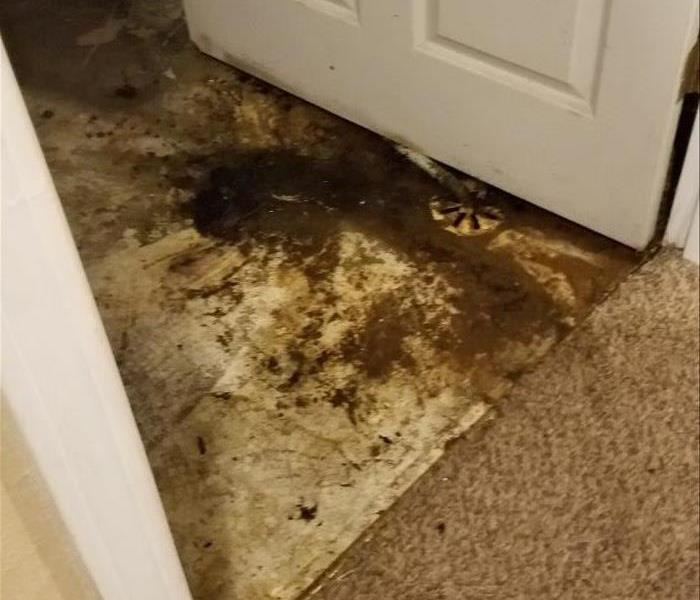 Keep your drains clean
#SERVPROsouthwestwaukeshacounty
Keep your drains clean
#SERVPROsouthwestwaukeshacounty
Here is information for a homeowner to add to their never ending home-maintenance checklists. Drains and sewer lines are something that is not thought about on a daily basis or ever thought about. Your drains are the central nervous system of your home, carrying away the water you use in your sinks, showers, and toilets daily.
With the holidays fast approaching, it’s good to understand the importance of caring for your drains and sewer lines. The holiday season is great because it allows us to spend time with our families and friends. Unfortunately, it’s not uncommon for drains to get clogged because of all the activity going on during the holidays.
Read the entire blog on West Bend's website for further information and tips on keeping your drains clean.
How To Change A Water Supply Line
12/13/2019 (Permalink)
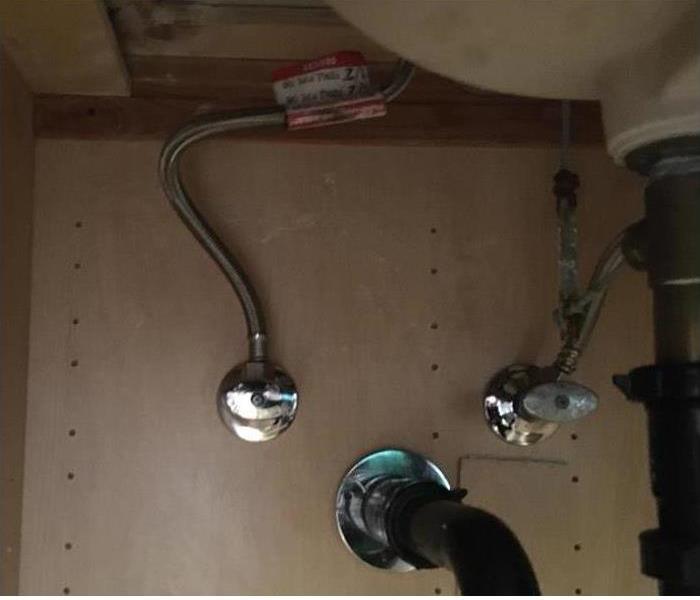 Water Supply Lines Like These Should Be Replaced Regularly
Water Supply Lines Like These Should Be Replaced Regularly
It is recommended to change your water supply line each time that an appliance (toilet, wash machine, faucet) is replaced. However, often times years will go by without replacing these very important devices. If you have not replaced this equipment recently, it is recommended to replace the water supply lines every 5 to 8 years. Just like other items that break down over time due to normal wear and tear, the tubes or rubber or plastic can wear down as well.
Please follow these tips when changing a supply line in your home or business.
1. Turn off the water to the toilet or sink or washer and flush it or drain the lines accordingly. If possible, turn the water supply valve to the right until it’s tight, then flush your toilet and tank or lines to drain out the water. If you do not have a water supply shut-off valve, contact a local licensed plumber to install one. If you don’t remember to flush the toilet, you could end up dumping a bunch of water all over your bathroom floor later on the in the process. Also, it may be a good idea to soak up all the water that has leaked out onto your floor if you haven’t already. Bathroom floors can be slippery when wet.
2. Loosen and remove the old supply line. Take your wrench and loosen the hex-nuts that connect the supply line to both the supply valve and toilet tank or other items. Remember: Once the hex-nuts are loose the old supply line should easily lift free.
3. Put the new supply line into place. Take your new supply line and attach one of the ends. It doesn’t matter which end you choose to install first. Line it up and use your fingers to tighten the hex-nut into place. Now, attach the opposite end and use your fingers to tighten the hex-nut into place. Then take a wrench to tighten the hex nut.
4. Turn on the water to the toilet. Now that your supply line is in place, all that’s left is to turn on the water and make sure that it’s working properly. SLOWLY turn the supply valve to the left until you start to hear water running and, for a toilet, you see water filling the toilet tank. As the tank is filling, be sure to keep an eye on your supply line and look for any leaks.
Call SERVPRO of Jefferson County/Oconomowoc for all your water damage clean-up needs. (920) 674-3002.
3-Day Drying Is A Goal - But Not Always Possible
12/6/2019 (Permalink)
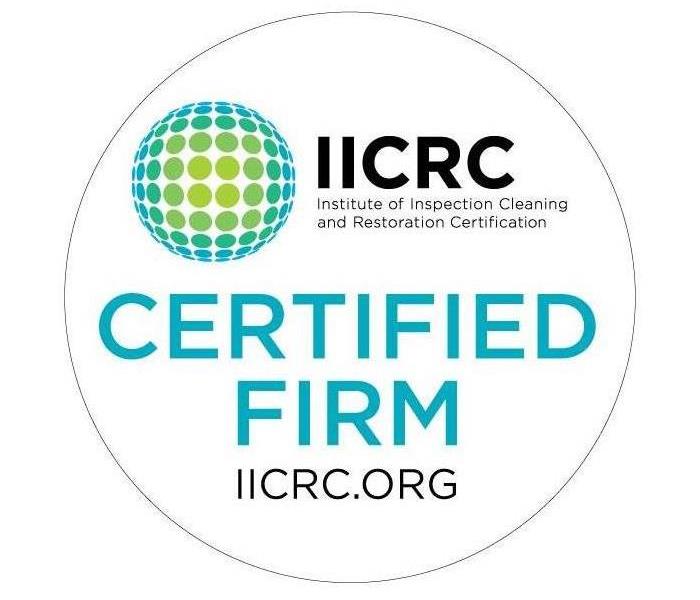 SERVPRO of Jefferson County/Oconomowoc is an IICRC Certified Firm
SERVPRO of Jefferson County/Oconomowoc is an IICRC Certified Firm
In the 1990s and early 2000s, restorative drying science was in its infancy but was evolving as some thought leaders in the restoration industry began taking a more scientific approach. Restorers were rapidly becoming restoration specialists, and in the process, they were learning what worked and what did not work. Those restorers worked to understand the science that impacted their business and developed the technology still used today.
As restorer confidence began to grow, the training of restorers needed to grow as well. The term Applied Structural Drying (ASD) became known in the industry as a drying course. The Institute of Inspection, Cleaning and Restoration Certification (IICRC) stated in its IICRC S500 V3-2006 standard, “Currently, among the IICRC’s 38,000 registered technicians, approximately 24,000 are IICRC-certified as Water Restoration Technicians (WRT), with approximately 4,500 of those being certified in Applied Structural Drying (ASD). This number is growing daily. ASD is primarily a hands-on course in which demonstration houses representative of standard residential construction are flooded, extracted, monitored, and dried throughout the three-day course – although three-day drying cannot be guaranteed.”
Everyone was going to these classes, from contractors to adjusters to property managers. The fact that a restorer could reduce the cost of rebuilding a structure substantially impacted the bottom line of the final customer, reduced cycle time, and decreased rebuild costs.
The issue with these classes was that they consisted of a three-day class. The perception was that structures could be dried in three days. The reality is that many of these structures remained wet for three to four days after the class ended.
The untold truth was that even with a sanitary environment with limited contents, more than enough power and with known quantities, known saturation times, and a repeatable process, these buildings still required additional days to dry.
Some contractors and adjusters believe contractors are in possession of technology, equipment, and training that can dry structures in three days. The fact remains that these sceptics are hard pressed to substantiate their comments. Moreover, publishing erroneous materials can lead to serious conflicts between contractors and adjusters rather than assist in fair and scientifically sound practices.”
Drying Science in 2019
In 2019, the science has evolved, the equipment has evolved, and restorative techniques have dramatically improved. But with all this improvement and knowledge one thing is true – three-day drying is not the norm. Stephanie Beattie of the Center for Disaster Recovery in Barrier, Ontario stated the best statistics show we went from an average of 6.2 days in 2016 to 4.9 day in 2018.
There has been plenty of research by the restoration (restorers) community and building science (engineers) community to substantiate the fact that not all materials can be dried in a specified, arbitrary time of three days. As a matter of fact, many structural materials will dry in varying degrees, depending on saturation time, atmospheric conditions and the material’s location in the building composition.
For the most part, today’s reviewers do not look at the goal of the drying project; they look at the costs of the job. The measurable cost of the job is more important than the successful drying of a project. But are those clients actually saving money? Did you help them understand the true savings?
Nobody can pinpoint where the three-day drying standard entered the industry. But the fact is three-day drying was incorrect in 2009, and three-day drying is incorrect in 2019. Based on the science we know today, it is not just incorrect, but it is potentially dangerous, and the liability of applying this standard has dramatically increased to both the contractor and the carrier.
Today, the indoor environmental profession knows more about the effects of contaminated indoor environments and the effects of mold on occupants and highly sensitized individuals. If contractors and their customers are not aware of these risks and do not address properly drying a structure, it can dramatically increase the potential for litigation and there is no limit on that liability.
We are proud to say that SERVPRO of Jefferson County/Oconomowoc is an IICRC Certified Firm. Contact SERVPRO Jefferson County/Oconomowoc for all your water damage needs or inquiries. (920) 674-3002
Ways to Avoid Frozen Pipes While On Vacation
11/20/2019 (Permalink)
 Beach Vacation - Where We Want to Be During The Wisconsin Winter
Beach Vacation - Where We Want to Be During The Wisconsin Winter
Anyone that has lived in Wisconsin knows how brutal our winter months can be. We all look forward to vacations to escape the cold weather and dreary days. However, before you leave for that vacation you have been patiently waiting for, be sure to protect what is probably your biggest asset, your home. Many times each year SERVPRO of SW Waukesha County is called to properties during the winter months that were not properly prepared for the cold weather before the occupants left. Please read the other blog about Tips to Prevent Pipes From Freezing, but the following are tips to follow before going on that vacation.
WAYS TO AVOID FROZEN PIPES WHILE ON VACATION
- Set the thermostat in your house no lower than 55 degrees Fahrenheit
- Be sure to replace the battery in your thermostat
- Ask a friend or neighbor to check your house daily to make sure it is warm enough to prevent freezing
- Shut off the main water supply and drain the water system. (Be aware that if you have a fire protection sprinkler system in your house, it may be deactivated when you shut off the water)
The certified water restoration technicians are available at SERVPRO of SW Waukesha County to help you if you experience water damage. Call us (262) 542-0900
Asbestos Abatements Recommendations from SERVPRO of SW Waukesha County
11/13/2019 (Permalink)
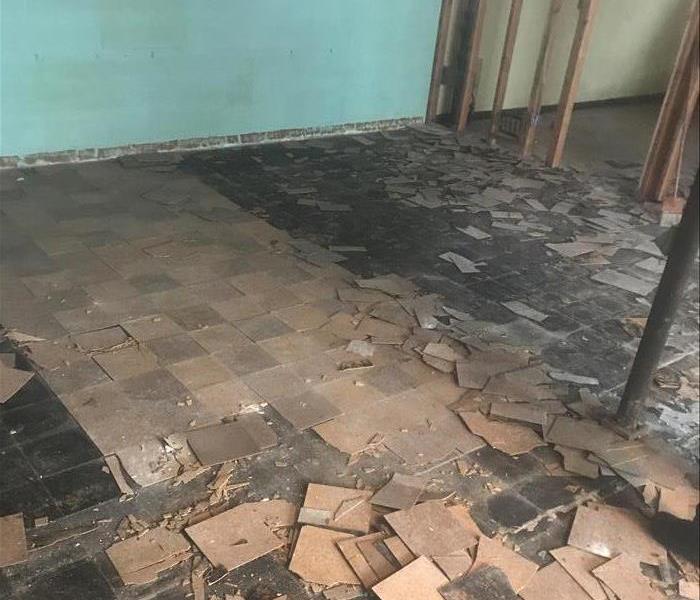 Vinyl Asbestos Flooring Tore Up by Homeowner
Vinyl Asbestos Flooring Tore Up by Homeowner
After a leaking pipe in a dishwasher burst and flooded the kitchen and basement of a residence, an ambitious homeowner decided to remove wet floor tiles from his basement with an ice chipper. This homeowner did not think of the possibility of the tiles containing asbestos fibers. After speaking with a friend and being warned about the possibility of that floor containing asbestos, he received a recommendation to call SERVPRO of SW Waukesha County. A Wisconsin state certified asbestos inspector with SERVPRO of SW Waukesha County inspected the project and took a sample of the material to be analyzed in an accredited lab. The result was positive for containing chrysotile, the most common form of asbestos. The home owner did the floor removal without containment or proper equipment and potentially may have contaminated the entire home through the running HVAC system. The homeowner is now responsible for the cost to decontaminate all the drying equipment that was put in place by another restoration company, and the cost of an entire asbestos abatement throughout the affected area.
If your home was built prior to 1990, and you have an original floor covering like vinyl, linoleum, floor tile, etc., it is highly recommended you have the flooring tested for asbestos before disturbing or removing the material.
SERVPRO of Southwest Waukesha County is the only SERVPRO franchise in the state of Wisconsin that is certified to provide asbestos testing and abatement services. Give us a call at 262-542-0900 with any questions.
Homeowner Makes Mistake And Tries to Remove Asbestos Flooring Himself
11/13/2019 (Permalink)
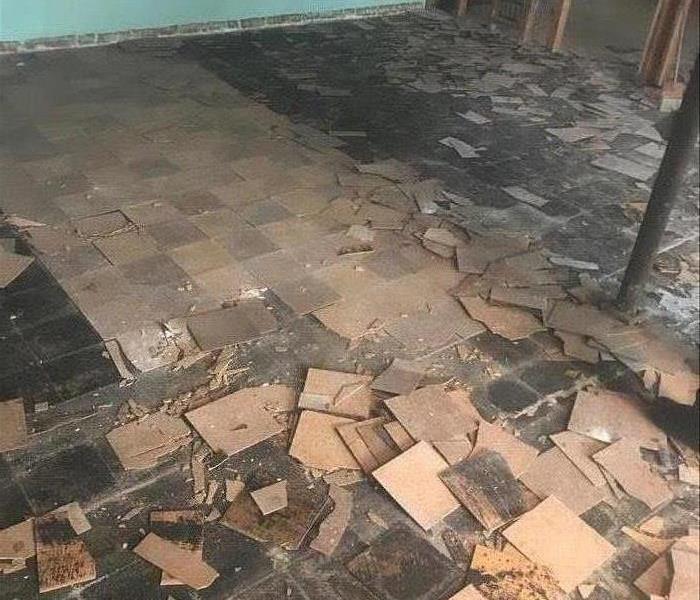 Asbestos Containing Vinyl Flooring Partially Removed Incorrectly By Home Owner
Asbestos Containing Vinyl Flooring Partially Removed Incorrectly By Home Owner
After a leaking pipe in a dishwasher burst and flooded the kitchen and basement of a residence, an ambitious homeowner decided to remove wet floor tiles from his basement with an ice chipper. This home owner did not think of the possibility of the tiles containing asbestos fibers. After a friend saw what he was doing and informed him of the possibility of asbestos being disturbed, he contacted SERVPRO of SW Waukesha County. The state certified asbestos inspector with SERVPRO of SW Waukesha County assessed the project and took a sample of materials to an accredited lab for analysis. The floor tile turned out positive for chrysotile, the most common form of asbestos. The home owner previously removed the flooring without containment or proper equipment and may have contaminated the entire home through the running HVAC system. Unfortunately, the homeowner is now responsible for the cost to decontaminate equipment and the cost of an entire asbestos abatement throughout the affected area. This could all have been avoided if he would have called a certified asbestos abatement company.
If your home was built prior to 1990, and you have an original floor covering like vinyl, linoleum, floor tile, etc., it is highly recommended you have the flooring tested for asbestos before disturbing or removing the material.
SERVPRO of Southwest Waukesha County is the only SERVPRO franchise in the state of Wisconsin that is certified to provide asbestos testing and abatement services. Call us to discuss your possible asbestos concerns at 262-542-0900!
Local Weather Report: Rainwater and Tornadoes,
10/3/2019 (Permalink)
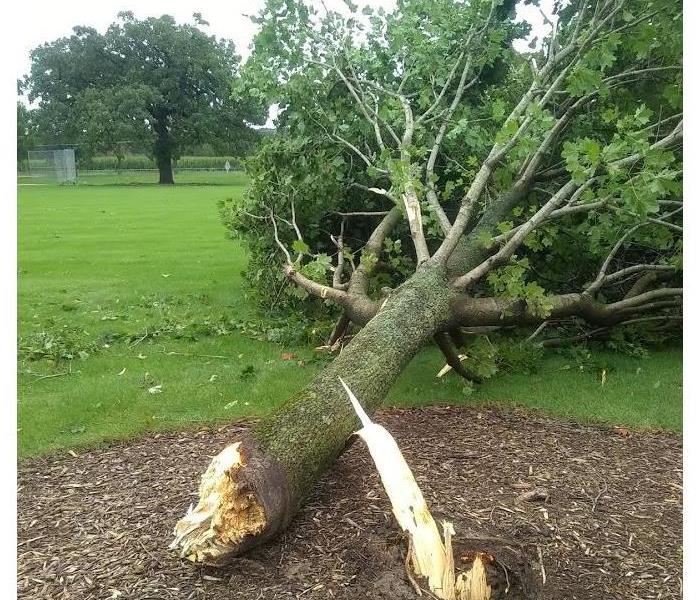 The National Weather Service reported 6 different cities that were affected in Southern Wisconsin on October 1st.
The National Weather Service reported 6 different cities that were affected in Southern Wisconsin on October 1st.
Violent thunderstorms dropped anywhere between 5-8 inches of rain water and produced two Tornadoes on Tuesday, October 1st 2019. The National Weather Service office in Sullivan followed by surveying the storms' aftermath.
From what they calculated, numerous trees were snapped or completely uprooted! Roofs were damaged on several buildings. Trees were blown down, including one that landed on a house. Also, a construction trailer "that was not there before the storm," reportedly ended up in someone's yard.
These storms in our area, just keeping getting worse and worse. And they show no signs of stopping!
Luckily, there were no immediate reports of any injuries as a result of the storms.
The flooding from these never ending storms, has closed multiple roads and wreaked havoc across the state. We urge all residents to be mindful of their delayed commutes to and from their work and homes.
Nearly every day, flooding happens somewhere in the United States or its territories. Flooding can cause more damage in the United States than any other weather-related event...with an average of 8 billion dollars a year. Flooding is also one of America's most underrated killers, causing nearly 90 fatalities per year.
Good preparation and knowing what to do in a flood will increase your safety and chances of survival if it happens in your area. It can also help minimize potential flood damage and accelerate recovery efforts.
Scoping Tools
10/3/2019 (Permalink)
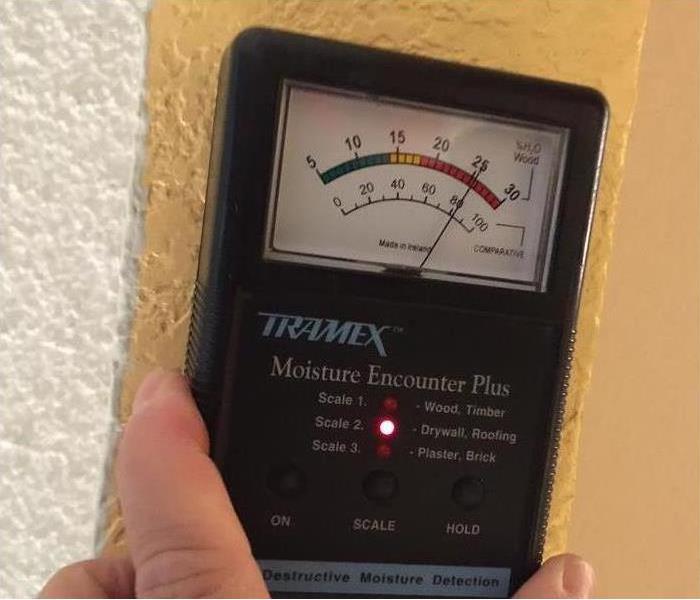 SERVPRO Moisture Meter
SERVPRO Moisture Meter
How do we detect the extend of water damage from water leaks, bathroom overflows, storm flooding and the many other causes of water damage? We at SERVPRO of Southwest Waukesha use industry standard scoping tools to detect moisture levels. This allows us at to effectively dry the affected areas with state-of-the-art drying equipment.
Scoping involves locating the areas of the structure affected by water and defining the extent to which the structure and contents have absorbed moisture. Moisture detection devices are also used to verify that an environment has been dried thoroughly. SERVPRO of Dane County West uses the following equipment:
- Moisture Sensors are used to detect moisture in carpets, baseboards and walls.
- Moisture Meters are used to determine the actual moisture content of various materials. The moisture tester provides accurate moisture readings that enable SERVPRO of Dane County West to monitor the drying process.
- Thermohygrometers measure both temperature and relative humidity. Capturing these two readings, a SERVPRO of Dane County West Professional using a psychrometric chart can calculate specific humidity, dew point and vapor pressure.
Once the scoping is completed and the affected areas are identified, we use Psychrometry to measure and evaluate air conditions to create the proper atmosphere for optimal drying. Psychometry is the study of the air and its properties of temperature, humidity, vapor pressure and dew point. They are are measured to evaluate air conditions in the structure, enabling SERVPRO of Dane County West Professionals to create the proper atmosphere for more efficient drying.
Water can damage materials in two ways: first, by absorption through direct contact with water; and second, absorption of moisture from the air. Measuring the moisture content of the air is critical to the drying process.
They also understand how to manipulate temperature and humidity levels to produce optimum drying conditions with state of the art detection equipment, without causing secondary damages through improper drying processes.
Bursting Pipes are no match for Quick Respondents
10/2/2019 (Permalink)
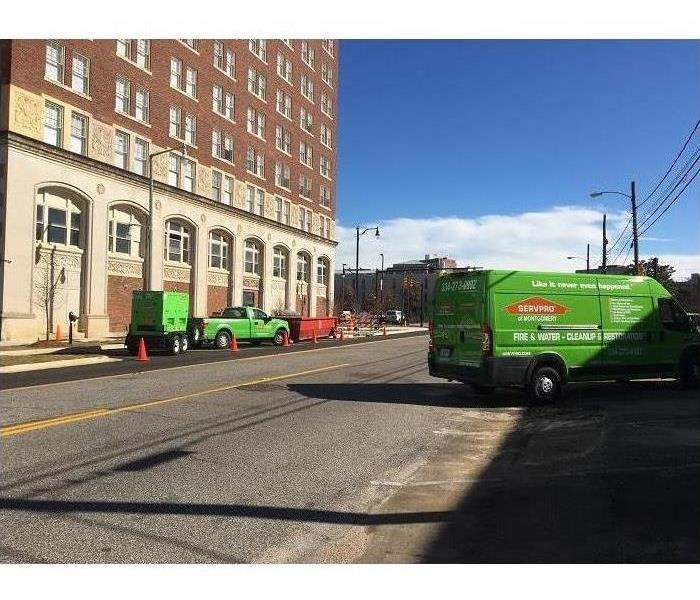 No job is too big for SERVPRO.
No job is too big for SERVPRO.
A large manufacturing company had a pipe burst above the acoustic tiled ceiling in a conference room. The water leaked across 5000 + sqft of the building. Impacting the carpet and drywall in the main office area, the hallways, bathrooms, and even the elevator shafts. The manufacturer decided to call in our franchise of SERVPRO to help them get their plant back into order.
We met with plant managers, operations managers, and office managers to formulate a action plan. Specific documentation was done immediately of the damage to show the insurance company as we could not wait for them to show up before we began work. After documentation of a space was completed SERVPRO got to work to mitigate the water damage.
We started first by using a weighted extraction method on the carpeted areas. Rubber cove was removed from areas with wet drywall, production staff then drilled coring holes in the drywall below the top of the rubber cove for air flow to get into during the drying process.
After initial stabilization and mitigation was performed SERVPRO started to set a very large number of drying equipment.
While our production staff was performing that work the production manager and mitigation manager continued documentation and organization of sub-contractors needed for supplemental power, plumbers for plumbing repairs, and the clearing and inspections of elevator shafts.
After all physical mitigation work was done the drying equipment pulled out all the excess moister in the structure. After that was completed the structure was put back together to look better then it started pre-pipe burst.
Operation Homefront
9/10/2019 (Permalink)
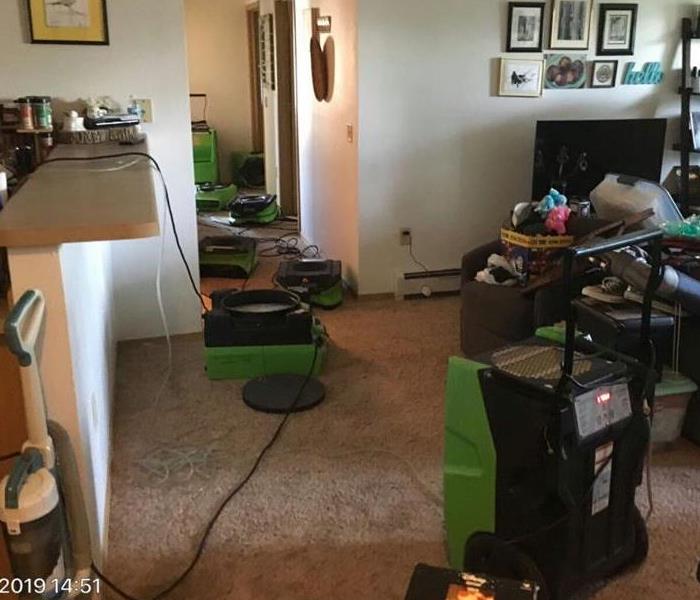 Upper Apartment with Water Damage
Upper Apartment with Water Damage
On Wednesday, July 17 we received a call from an apartment property manager that described a emergency water loss that affected two units, an upper and lower. Tenants living upstairs started a load of laundry and then went to work. While at work the wash machine failed to turn off and it continued to fill and spill over. Eventually the water migrated to multiple rooms in the upper unit. However, as expected, the bulk of the water damage went to the tenants living directly beneath.
Upon the arrival of SERVPRO and scoping the loss, it was quickly determined that both units were severely affected. As you can imagine the tenants down below, a young couple, received the brunt of the water damage. Their apartment was severely effected and there was no way that this couple and their two dogs could continue to live there. Fortunately for them, the couple did have renters insurance. It was then brought to our attention that the male tenant was in the Military and he pointed out that he was being deployed overseas in only 3 days! The couples' plan to spend the last two days they had together was now gone, and emotional devastation overtook them. Todd, the owner of SERVPRO, stated that we would do everything in our power to help resolve this quickly. It is difficult enough to worry about your significant other being deployed overseas, but then having to worry about finding a new place to live and what to do with the two dogs and then having to move your contents out would be overwhelming for anybody. A burden we would not let our clients face alone. With all the work that needed to be coordinated and completed, it takes time to accomplish all this. Overall, it the entire process took about 15 days. We are very happy to report that the job is now complete! The most gratifying feeling was knowing that we could help the Military couple and that they could spend as much time together with family and friends with a little less stress on their plates.
Water Damage Process
7/23/2018 (Permalink)
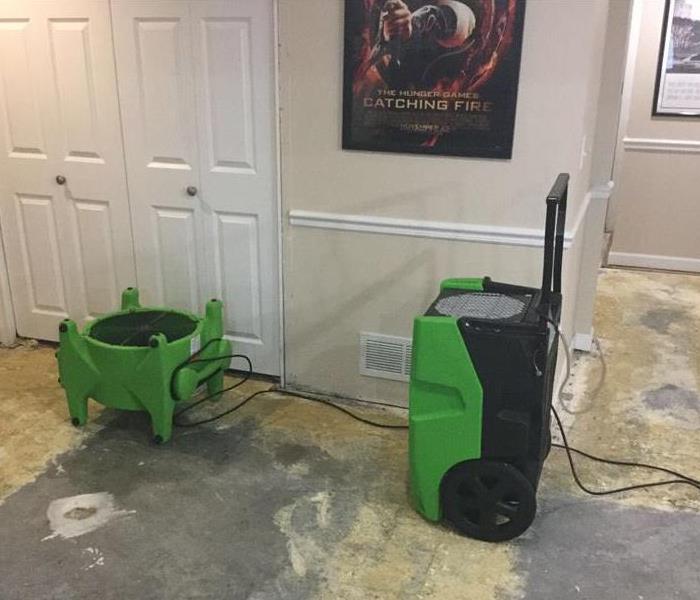 #SERVPROsouthwestwaukeshacounty
#waterdamage
#SERVPROsouthwestwaukeshacounty
#waterdamage
SERVPRO Water Damage Restoration
SERVPRO® crews implement a course of action for restoring a property that has water damage. A quick response is key to preventing further water damage.
There are five fundamental principles for water damage restoration which are noted in The Institute of Inspection, Cleaning and Restoration Certification (IICRC) S500 Standard and Reference Guide for Professional Water Damage Restoration:
- Mitigation
- Drying Plan
- Cleaning and Repair
Safety is the primary concern on a job site. It is important to make sure the crews and the occupants are informed and protected from any safety issues.
Documentation is important to create an action plan for the project. At SERVPRO® we use DryBook® which is used on iPads that the crews bring on every job. Using DryBook® helps our crews document everything that is happening on the job, how to create a drying plan and to make sure the structure is drying properly.
Mitigation is important because it helps the occupant recover more quickly from the water loss event.
Drying plan includes removing excess water, extraction, evaporation and dehumidification. Drying equipment is placed to remove moisture through evaporation and dehumidification. Temperature is also important to increase the rate of evaporation.
Cleaning and repair are done when the drying plan is complete and drying goals have been met. This is to repair and clean the property to preloss condition.
Flooded Basement
4/26/2016 (Permalink)
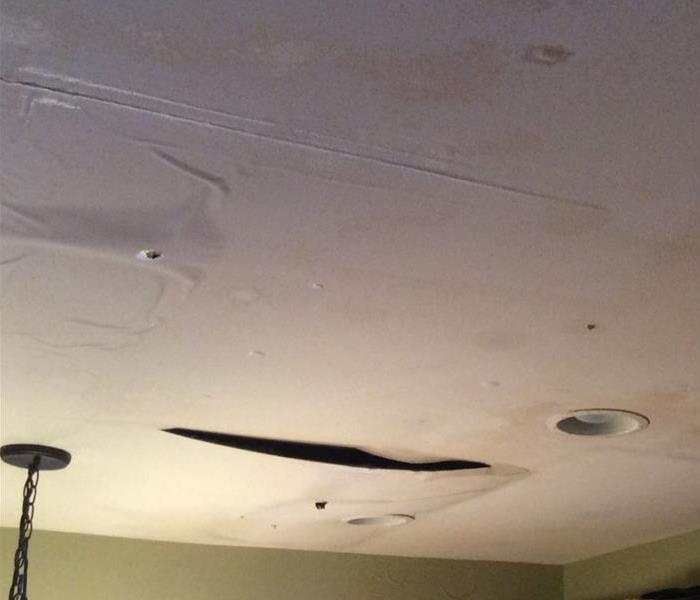 A pipe burst in the walls which caused water damage to this homeowners bathroom, kitchen, and basement. The photo is from their basement ceiling.
A pipe burst in the walls which caused water damage to this homeowners bathroom, kitchen, and basement. The photo is from their basement ceiling.
Waukesha County Residents: We Specialize in Flooded Basement Cleanup and Restoration!
A basement can flood at any time, although flooding most often occurs during heavy rainfall. Basements are inherently prone to flooding because they are the lowest level of a building and are normally built partly or entirely below ground level. There are a number of reasons why your basement could flood, including:
- A blocked or failed sewer lateral pipe
- Heavy rain causes surface water to pool around your home
- Storm sewer backup
- Sanitary sewer backup
- Foundation drainage failure
- Water supply-line break or hot-water tank failure
- And many more
Have Questions about Basement Flooding?
Call Today - 262-542-0900
If flood water is not handled quickly and properly, it can jeopardize your health and safety, and cause severe damage to your home’s structure. Remember, the longer you wait, the worse the problem will get.
The bottom line: a flooded basement can jeopardize your health, safety, and your home’s integrity. It’s worth making a call to SERVPRO of Southwest Waukesha County and let our trained, professional crews handle the situation safely and correctly. We have earned the trust of hundreds of homeowners, business owners, and property professionals.
We are Flooded Basement Specialists:
- We are Available 24 hours/7 days per week
- We’re a Preferred Vendor to many National Insurance Companies
- We Bill The Insurance Directly – One Less Thing For You To Worry About
- Our Technicians are Highly-Trained in Water Restoration Techniques
- We use s500 IICRC Restoration Standards
- Advanced Inspection and Extraction Equipment
Basement Flooded? Call Us Today – We’re Ready To Help 262-542-0900
Tip of the week
3/30/2015 (Permalink)
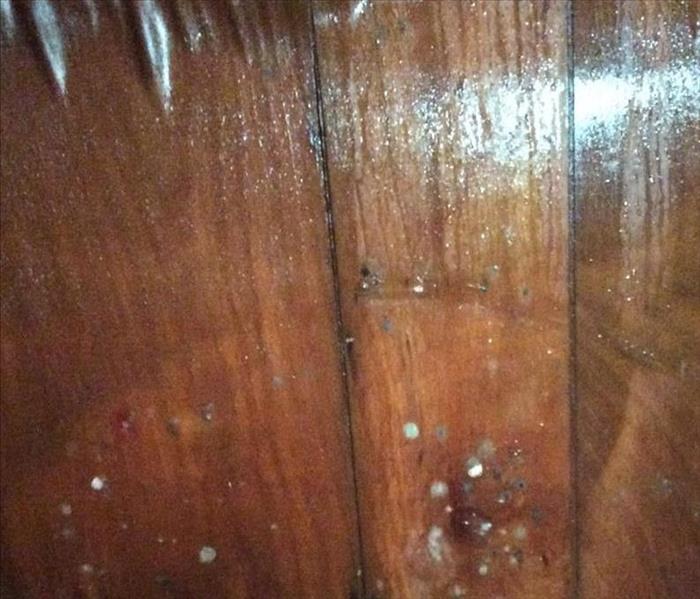 This photo shows mold growth on wood paneling due to water damage.
This photo shows mold growth on wood paneling due to water damage.
Happy Monday!
Over the weekend our crew at SERVPRO of Southwest Waukesha County went to a job site that had water damage. The homeowner was out of town, but a neighbor was watching the house and discover that a pipe had burst. There was water all on the carpet and pad as well as the furniture in the room was damaged by the water.
Our crew discovered that there was more than water damage at this property; mold had started to grow on the wall and other content in the room
This is a reminder to shut off your water if you will be gone for a long period of time. You never know if a pipe would burst or a toilet would overflow while you are gone.
If you have any questions regarding this tip of the week, please call SERVPRO of Southwest Waukesha County at (262) 542-0900.

 24/7 Emergency Service
24/7 Emergency Service
